#(what with the giant cell...nucleus.... thing)
Explore tagged Tumblr posts
Text
What
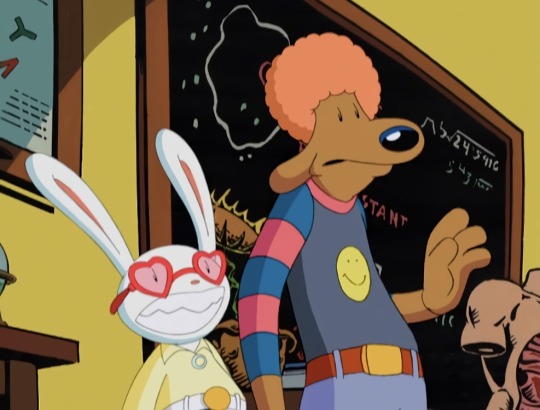
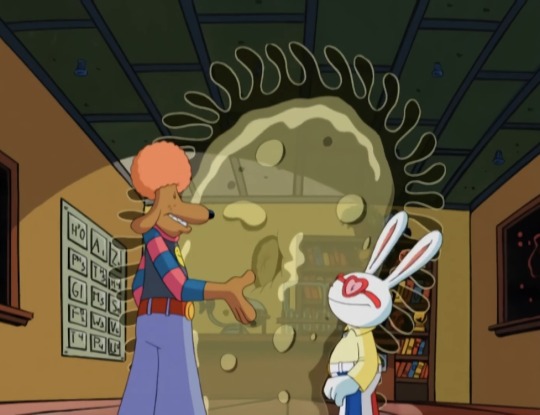


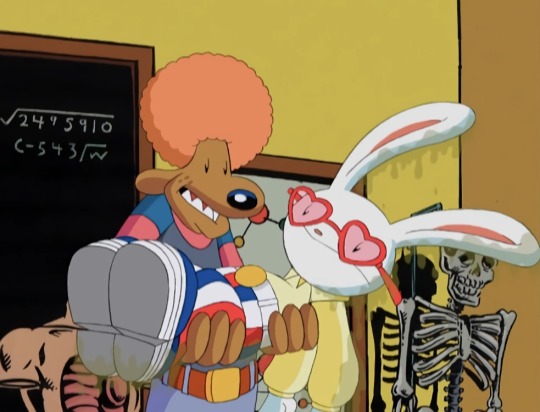


hot take ig but i don't think teen sam & max's designs are as awful as people make them out to be
OK WELL. there are 2 exceptions. absurdly skinny sam is just. no. and the hair is a *very odd choice.* funny, but odd nonetheless. other than that they're really not that bad
i usually see people complaining the most about sam randomly spawning hair (fair) and the outfits. this may be silly of me but i actually really like the outfits... they're very reminiscent of "animated teens in kids media with overly layered and goofy ahh clothes" type outfits from stuff i used to watch as a kid (i.e. strawberry shortcake 2003 & berry bitty adventures, equestria girls, barbie life in the dreamhouse, etc) and they're actually super charming to me lol. they're dumb, but like "teen gay fashion disasters" dumb. aka very whimsical and i love them. i don't see kids my age dress exactly like that obviously, but i've seen many-a-teen dress with the same level of fashion competence. hell, i would absolutely dress like teen max from time to time if i thought i could pull it off.
also they're just really awkward and adorable designs lol. the facial expressions and the way max hopped into sam's arms even as teens is super cute, plus sam with freckles gives me life.
anywaysssss i'm really busy this week but expect to see teen sam & max redesigns from me when i have time :3
#dri's rambles#sam & max#sam and max#the adventures of sam & max freelance police#sam and max freelance police#teen sam and max#tw gross#(what with the giant cell...nucleus.... thing)
50 notes
·
View notes
Note
what is the most frustrating thing in taxonomy in the worlds of this?
WHERE DO I START WITH THIS ONE.
Riakhou are fairly simple, taxonomically. Sure, they've had a lot of genetic modifications but since their homeworld was likely destroyed in the supernova explosion of their sun, we don't have enough material on them to actually... put together the phylogenetic tree of their homeworld and see exactly which parts of them bring them closer to which branches of said tree. If we had we could probably have some fun with that but oh well.
You know who is NOT simple though?
Gileñavu. Affectionately known as Turtle-Deer-Whales.
And the fact that their government will not let us see what they're hiding in the ocean! /j
Anyway. Gileñavu! They are genetically more similar to Cetaceans (who live on Eisheza, the PLANET NEXT DOOR) than to some species on their own homeworld. And this isn't even scratching the surface of it, oh no. According to some scientists there is a chance they could probably produce an infertile hybrid (like a mule) with some whales (Maybe Rorquals/Balaenopteridae). That’s how similar they are to whales. Not their shells though. Their shells are a symbiotic organism more similar to rest of l'Nouan life than Gileñavu are. Sort of like if a coral lost most of its life adaptations and relied on another species to sustain it. (NOT SO FUN FACT. While a gileñavu could survive without its shell with proper care (the shell is fused with its spine, so it would end up paralysed), the shell cannot survive without its host).
But gileñavu pre-sapient ancestors also had those shells, so that symbiosis has been going on for AT LEAST 950,000 years, maybe more. Scientists don't even know where to START with this one. Unfortunately, because l'Noua does not have dry land anymore, and also because gileñavu authorities can be very conservative and distrustful of alien scientists, archaeology there is extremely hard.
We do know that Gileñavu are descended from.... well, ungulates that lived on l'Noua back when it still had dry land, but as the planet flooded most species re-evolved aquatic adaptations. This is also where gileñavu antlers come from. Somehow the appeal of a rack on the head was strong enough to let this trait be passed on for millions of years, even if it's very impractical in water.

^ A prehistoric terrestrial Gileñavu ancestor, from way before the icebergs melted and the planet flooded.
Anyway. What IS the deal with gileñavu?!
Is it like carcinisation where just like all arthropods become crabs all big sea mammals become whales? Or like that bird that re-evolved from being extinct? Did something happen in planetary history that we might not know about that explains it? WHO KNOWS! NOT US!
The most common theory is that. An asteroid brought life (or life building blocks) to Eisheza and l'Noua. That it split in two and hit both and this is why life on those two planets is so similar. But a counter-argument to this is that life-building-block bearing asteroid would have come so long ago that even if these two planets developed life from the same building blocks! Unless the asteroid was also somehow carrying blueprints for life to develop which is yet another can of worms.
Every planet has its own weird little niches that are fascinating and that some may find baffling. Like some Wuvumian "trees" whose cells don't have a nucleus making them the largest known 'prokaryotes' we know of.
Or a certain anhydrous lifeform found by asteroid miners that can shift between an active slime-mold like form and a dormant crystalline form making them as resilient as tardigrades.
Or various forms of life found in the atmosphere of a gas giant in a star system nearby (so far only photographed).

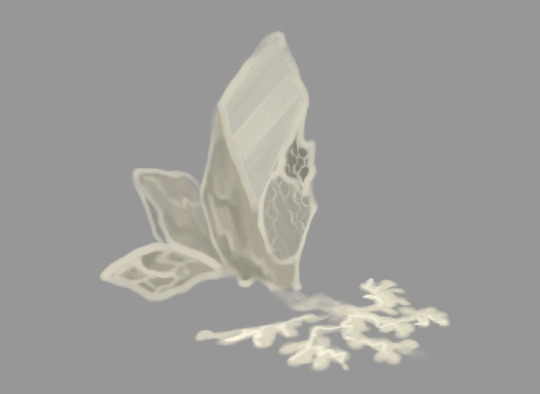
TL;DR:
Riakhou are not the worst offenders here. Gileñavu are. As for other life forms we probably have not gone deep enough to discover all the weirdness that will cause us to write long winded lamentations on our hatred of taxonomy and evolution.
13 notes
·
View notes
Note
PERSONALLY, I would avoid putting the Chia in Protist/Monera/Vira. Protists are a wastebin taxon, Monera don't have nuclei (I'm assuming the large blue blob in the Chia is the nucleus... ?), and I'm guessing 'Vira' is viruses - but those aren't actually alive :v I saw someone say it doesn't seem to have chloroplasts either so probably not a plant. Maybe 'large bacterium'??
i have to reread what i looked into on protist/monera/vira but what i can say right now is that for our purposes the superkingdom here is more of a catchall for anything that isn't fungi, animalia, plantae or alien. so protista might be the closest comparison, actually. i think i wanted to avoid making decisions on earth kingdoms since a few things get categorized multiple ways and i found a lot of contradictory discussions of how everything besides the big three get categorized. unfortunately though this could mean mixing up whole domains which, my god...
besides all that, though, in my mind, the relevant candidates are typically too small for us to pull apart and see whether they've got nuclei or even DNA so distinctions on this level start to become largely conjecture and it's just not worth getting into. so on top of mismatched taxonomic schema, it'd still just end up being a category of "very small things that we know aren't the other kind of things."
anyway bacteria (and archaea!) don't have nuclei, and fungal cells aren't too far of a reach either. also, i think it's debatable whether the green stripey bits in the Transparent Chia couldn't be chloroplasts. i would actually argue that the large interior blue balloon could be a large central vacuole. it would make sense for a Chia to be a plant given their unique chia pop colors.
but being one giant cell is extremely notable nonetheless. and we have so few candidates in our poorly named fifth kingdom, it would be such a boon to pull as big a name as the Chia. i'm rooting for kingdom 5 but I keep my mind open and attuned to the evidence as it comes in.
6 notes
·
View notes
Text
And it has to be stressed that eukaryotes aren't eukaryotes without their mitochondria, except for like one freak parasite who cheats.
It's believed that endosymbiosis is what allowed eukaryotes to evolve in the first place, that without the convenience of their little power structures that the complexity inherent to being a eukaryote is just impossible. The general consensus for what endo'd the symbiote is archaea, a weird cousin to bacteria (though this isn't unanimous or confirmed).
Every single one of your cells is a weird bacteria/eukaryote symbiote.
Correction: every single one of your cells is a weird bacteria/archaea symbiote.
And there's even a theory that your nucleus is derived from GIANT VIRUS'S, of all things.
So if both of those theories are true, eukaryotes are basically 3 domains of life in a trenchcoat.

34K notes
·
View notes
Text
As a community, aquarists tend to become paranoid about 'hitch hikers', such as aiptasia (glass or triffid) anemones, and the entire clade of vermetid snails. As an online subculture, the community talks of these creatures as indestructible and existential threats, something more like fictional, movie xenomorphs, than what they are, real animals. Usually there exists a kernel of truth behind such fears, although aquarists folklore ignores the basic knowledge, that is relevant to their management - something more realist than a 'cure'. It seems strange today, but in the 1990s, any non-sedentaey polychaete could cause the majority of aquarists to panic. Of course the majority of them are harmless, and even helpful to the aquarist, because the common species are detrivores.
If the world of macroscopic plants has a counterpart in the 'reefer' imagination, it is surely that curious seaweed called bubble algae, or in other sorts of literature, sailor's eyeballs. We often call them all Valonia, and - with the caveat that I am not a botanist - I see no basis to doubt this. However the junior synonym Ventricaria is sometimes in use. These peculiar seaweeds - for they are unusual, green macroalgae - are all quite similar to one another, although some invest more energy in a larger 'bubble' - a spheroid to avoid body (or thallus), that is attached firmly to an underlying substrate - whilst others form a more creeping mat of smaller 'bubbles', because they may generate a stolon. It is the latter growth morphs that becomes invasive in our aquariums.
An curious and only half true bit of folklore about Valonia sp. is that they are the world's largest single celled organisms. Wether or not they are single celled is a matter of opinion, since they are miltinucleate, as are other green seaweeds of 'siphonous' type. Siphonous seaweeds are known to exist only among the green algae, with no counterparts among the brown or red algae, and to complicate things more, true multicellular algae have also evolved from non-siphonous, green algal ancestors. The 'giant cells' of siphonous algae contain numerous nuclei, each with its own 'cytoplasmic domain', whereas typical cells - of classically unicellular or multicellular organisms - possess but one cell nucleus. No cell wall separates the nuclei in the siphonous species, which is a basic difference from the truly multicellular plants.
Siphonous macroalgae thus exist outside of the familiar division of organisms into single or multiple cells, as we tend to take it for granted. For over one hundred years it has been pointed out, anyway, that the idea of a 'unicellular' organisms is flawed, on both semantic and empirical grounds. To begin with an organisms without cell walls is undivided, and therefore it cannot contain cells; also the 'cells' of what we call 'unicellular life' do not function entirely like the cells which act as the mere compartments of larger, living entities.
It is a frustrating description, but it is one that has stuck, and siphonous algae - and similarly multinucleate organisms, such as the famous slime molds -are clumsily expressed as 'giant cells'. If we view them as unicellular, then they surely are the biggest 'single celled organisms' in the world, but it is not the bubble algae would hold that title. Much larger siphonous macroalgae exist - such as Caulerpa sp and Halimeda sp. - that would wear that particular crown, sharing as they do the same siphonous nature as Valonia, and yet growing much, much larger.
Some people think that crabs which eat Valonia actively spread or, by releasing it's spores which are stored inside the globular thallus. This is nonsense because no spores are inside the plant, due to its structure making this impossible. This is not how the bubble algae multiply, although any intact 'cytoplasmic domain' can regenerate to form a complete Valonia organism. This is true of other siphonous algae such as Caulerpa, and neither makes bubble algae unique nor invincible. Without interference the bubbles multiply through division, which is also normal for such 'giant cells'. They also release new individuals via pores on their cell wall, and Valonia actually resembles, in its organization, the reproductive organs of some other siphonous algae
Incidentally the Mithrax group of crabs, including the emerald crab, M. sculptus, effectively consume Valonia; the problem is, their diets are broader than algae alone, and they are opportunistic foragers of sessile animals such as corals, and even slow, motile prey, such as snails. The popular focus on the emerald crab as a control agent of Valonia, is because few other herbivores find them palatable. In the wild they seem to be held in check by other, competing algae, and Valonia is commonest where these competitors are relatively absent. Some of the saccoglossan snails may be found on bubble algae, but most saccoglossan species will not consume it.
This is not to say that no other animals eat Valonia, but their extracts are known to be unappetising to herbivorous fishes. The fact they seem to profit where sea urchins graze on other algae, also points to their general unpalatability. It's curious that Siganus argenteus, a strictly vegetarian siganid, shows an actual preference for Valonia as food, whilst to another siganid, S. spinosus, the extracts are distasteful. Two species of the acanthurid genus Naso - N. lituratus and N. unicornis - are also verified to consume these macroalgae, whereas Acanthurus nigrofuscus and Zebrasoma flavescens do not It seems that the will to eat Valonia has evolved in fishes inhabiting those habitats, where they are relatively common as a potential food source.
Valonia is an adaptable enough genus, and can be found in harsh situations such as the intertidal zone, where it might be exposed to tropical air for hours of the day. Unsurprisingly, hardy algae of this kind easily survive transport on damp but emersed 'live rock' whilst it is transported by aeroplane - more fragile organisms are much less likely to survive the long process of shipment and 'curing'. They can also be found as deep as 80 meters, showing a preference for relatively shaded and flow deficient microhabitats, for example between stones. They are common on solid substrates for this reason, and are found growing in the wild, in association with certain species of Caulerpa. Bubble algae may grow, in the wild, as epiphytes on larger marine plants, including an association with the mangroves.
Valonia sp. ought not to be conflated with the 'grape'-forming morphs within the genus Caulerpa, nor the red grape or bubble algae of the genus Botryocladia, which belongs to the classically multicellular red seaweeds. Newcomers to the hobby are confused by the grape-like bubbles of these plants. Both these genera have a very different growth habit and appearance, when they are compared to the Valonia - although the latter, too, are marine plants, despite their noteworthy growth form. And when they are viewed as what they are, siphonous algae, the genus Valonia are not so unusual or perplexing as they might at first seem.
#bubble algae#valoniaceae#green algae#seaweeds#macroalgae#valonia#genus valonia#siphonous algae#sea grape#sailors eyeballs#misunderstood fish#qaautomation#oddballs#coldwater tropicals
1 note
·
View note
Text
The tree of life offers many things, but a fern — which may seem like a not-too-complex organism — has turned out to be the living being with the largest genome. It grows in New Caledonia, an island in Oceania that’s part of overseas France. And, if the 160,750,000,000 base pairs of its DNA could be placed on top of each other, they would reach a length of about 300 feet… 50 times longer than human DNA. The recent discovery raises new questions about how much genetic material can be stored in cells and about the lack of correlation between complexity and genetics.
Tmesipteris oblanceolata grows on the fallen trunks of the forests of New Caledonia. It’s a fern that belongs to a genus of vascular plants, of which there are barely 15 known species. At least two of their first cousins were known to have giant genomes. But until now, the organism that contained DNA with what was thought to be the greatest number of base pairs was another plant, known as Paris japonica. Now, however, several researchers — who determined the genetic length of Paris japonica — have discovered that the genome of Tmesipteris oblanceolata is 7% larger.
In a new study published in the scientific journal iScience, researchers from the Royal Botanic Gardens of Kew (United Kingdom) and the Botanical Institute of Barcelona present the results of their analysis of this fern. They demonstrate that it has the largest amount of DNA stored in the nucleus of its cells compared to any living eukaryotic organism on the planet. If it were a tangle to unravel, Tmesipteris oblanceolata would extend between 344 and 347 feet.
“It’s not an iconic plant; it doesn’t have flowers, nor is it striking. In fact, it’s a weed that, if you’re not looking for it, you would trample without realizing it,” admits Jaume Pellicer, a researcher at the Botanical Institute of Barcelona. “It doesn’t even look like a fern, [or at least] it doesn’t look like the traditional image we have of them. But it has something that makes it special: it has a giant genome.”
In 2023, Pellicer and his colleague Oriane Hidalgo traveled to New Caledonia to collect samples of Tmesipteris, which they subsequently analyzed to estimate the size of its genome. This process required isolating the nuclei of thousands of cells, staining them with a fluorescent dye and then measuring how much dye had bound to the DNA within each nucleus. The more dye, the larger the genome.
“To calculate the size, we use internal standards [and] cultivated plants such as peas, rice or tomatoes, which are very well known,” Pellicer explains. In this case, the standard they used was garlic, which is the cultivated plant with the highest number of base pairs: 34 gigabases (one Gbp is equivalent to one billion base pairs). By comparison, the human genome contains about 3.2 Gbp spread across 23 chromosomes. And, when stretched, the length of DNA in each cell of garlic barely exceeds six feet.
“Tmesipteris is unique and fascinating… its ancestors evolved about 350 million years ago, long before dinosaurs walked the Earth. [The fern] is distinguished by its primarily epiphytic habit (growing primarily on tree trunks and branches),” Pellicer notes. In a video interview with EL PAÍS, he recalls that, when they encrypted the Paris japonica genome several years ago, they believed that they had reached the limit… that there could be no other organisms that were larger in genetic terms.
“The hypothesis that perhaps there was no greater diversity was based on the fact that there would be no possibility of biologically maintaining a genome beyond 150 gigabases. We were wrong,” he admits.
Such a large genome has its costs. It requires more energy resources when replicating DNA, or dividing cells. In larger cells, the integrity of the physical structure requires greater energy input. It’s more costly at a metabolic level. “That’s why we think it makes them less advantageous when it comes to adapting to constant changes, both [related to] climate and pollution,” Pellicer explains. The ferns have reproductive cycles that are much slower, because the cell cycle is much longer than in a plant with a small genome, while the demand for nutrients required to build nucleic acids is much greater. “We believe that, throughout evolution, they’ve slowly been [worn down],” Pellicer adds. In fact, he concludes, “giant genomes are the exception; despite the extraordinary diversity of genomic sizes that exist, the vast majority of plants have small or very small genomes, which is why we’re so interested in [large ones].”
Biologists call this the C-value paradox: the size of the genome doesn’t correlate with the complexity of the organism. This fact has puzzled them for decades. “It was thought that the more complex an organism was, the larger the size of its genome must be. Now we know that this isn’t the case,” Pellicer says. “And this is mainly due to the fact that most of the genome is composed of repetitive DNA sequences, which has been called ‘junk DNA,’ because it was believed that it had no function.”
When looked at with human eyes, none of the 10 organisms with the largest genomes could be seen as particularly complex living beings. In addition to T. oblanceolata and P. japonica, another fern from the genus of the first mistletoe — a European species — appears on the list, with 100.84 Gbp. In the top 10, there are only four animals, such as the marbled lungfish (129.90 Gbp) or the Neuse River Water Dog (117.47 Gbp), related to salamanders.
Pol Fernández, also a researcher from the Botanical Institute of Barcelona and a co-author of the study, gives some reasons for the order of the list of the largest genomes: “The majority are plants and, at the genomic level, they’re capable of being viable by doing many hybridization processes. When there are such gigantic genomes, it’s because there have been many duplications of genome amplifications of repeated elements. We know that this is much more frequent in plant species than in animals.”
To date, scientists around the world have estimated the genome sizes of more than 20,000 eukaryotic organisms, in the process revealing a wide range of genome sizes. These, in turn, have been found to have a profound impact, not only on their anatomy — as larger genomes need larger cells to house them and take longer to replicate — but also on how they function, evolve and where and how they live.
“Who would have thought that this small, unassuming plant, which most people would probably walk past without noticing, could hold a world record for genome size?” says Ilia Leitch, from the Royal Botanic Gardens in Kew. She adds: “Compared to other organisms, plants are incredibly DNA diverse. This should lead us to think about their intrinsic value in the broader picture of global biodiversity.”
“This discovery,” she concludes, “also raises many new and exciting questions about the limits of what is biologically possible. We hope to solve these mysteries one day.”
1 note
·
View note
Text
Brain fluid, Great ones, Blood and parasites.
I am replaying Bloodborne and I'm noticing a few new things.
I finally get to the research hall and read the brain fluids description again (in French & English)

Greyish amoeba-shaped brain fluid. Wobbles and bounces.
Extracted from a patient whose head expanded until that was all that they were.
In the early days of the Healing Church, the Great Ones were linked to the ocean, and so the cerebral patients would imbibe water, and listen for the howl of the sea. Brain fluid writhed inside the head, the initial makings of internal eyes. (…)
So… was i supposed to found out myself they actually have parasite inside ??
So one thing you need to know is that "brain fluid" or cerebrospinal fluid (liquide céphalo-rachidien/cérébrospinal en VF) is a transparent liquid where you have your brain and inside your spine for your nerves. It doesn't quite fit what we have in game right ?
But they did add water in it, right ? It also said (but it's more clear in French that it have an amoeba (amibe) shape.
What's an amoeba ? from wikipedia : "(...) is a type of cell or unicellular organism with the ability to alter its shape (...) Amoeboid cells occur not only among the protozoa, but also in fungi, algae, and animals. Microbiologists often use the terms "amoeboid" and "amoeba" interchangeably for any organism that exhibits amoeboid movement."
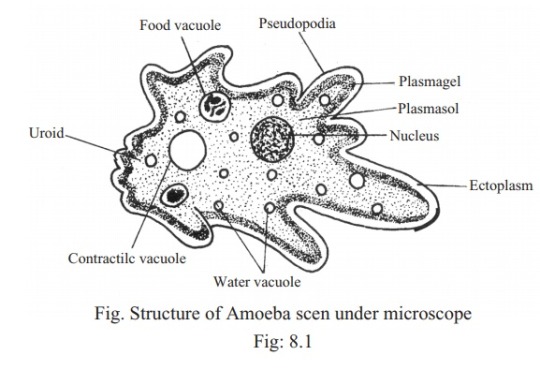
It's an eucaryote (membrane, cytoplasm and nucleus like our cells) and unicellular organism that can lived without and host in the earth or water for example (unlike our cells who need to be a part of a pluricellulaires organism).
But, there's some type of amoeba who act as parasite and actually can "eat" a brain💀 (actually it attacked the nervous system & cells from the cavity between the nose and brain ) do you see where I'm trying to get ?
The water they put inside the patients head... probably had microorganism inside it. If it's not the Kos parasites then others things really similar.
It will take too long to develop everything, maybe another day so really short : we know about the Kos parasite right ? And that Kos probably had parasites who infected and transformed the inhabitants of the Hamlet.
For the blood we literally have vermin, the loran silver beasts (+ the maggots), the bloodletting beast with the giant worms and the blood dregs. (the eyes that turned blind some parasite do that in real life too)
I thought at first that what caused the beast plague was "infected cells' like cancerous cells that created more organic materials, mutated their host and boom. And not just some bacteria or viruses (that is possible too XD but also vermin are those arthropods like parasites so I was a bit confused.
But now ! If we need to have a more scientifically and realistically approach about what happened in Bloodborne (and not just boom great ones dream magic) I think it can be caused by unicellular beings who composed the great ones and mess with everyone 👍
I mean diseases and organism disfunction (of the neural system for ex) are caused on a cellular if not molecular level after all (how molecules and drugs act in the neurons and synapses of the brain is really fascinating ! But it’s not easy to learn)
Also why are great ones so close to the first protozoan cells organism for some reason ?! There's multicellular organism I guess but exist on different planes of existence (if they're not aliens or smt) but bc of the parasites blood and all (odeon is kinda blood/ what we have in the blood) so they're probably really really old forms of life you (like unicellular organisms).I guess we could say that great ones are parasites of the mind !👈 👈 (ok enough of today)
Little bonus : the first unicellular appear between 3,5 and 3,8 billion years. The multicellular appeared 2 billions years ago, our Earth have 4,5 billions years, our solar system just a bit more and the universe is 13,8 billions years old. Homo sapiens sapiens (us) is like 200 000 years old 💀 but don't worry the homininae line appeared 10 million years ago!
Hey you know we're closer to the dinosaurs who lived at the end of the cretaceous (64Ma) than between the Dino of the cretaceous and the beginning to the triassic (first Dino : 230/250 Ma)? CRAZY HMMM ??????
Anyway I do believe Bloodborne universe is actually as fantastic as dark souls or Elden Ring and not super ultra realistic like our own world. Some things just doesn't make sense realistically and maybe don't have a possible realistic and scientific explanation (the dreams, great ones etc) but it's cool to try to used sciences to explain things in the universe ! That make its own world more coherent in its own logic I believe ! (it's like you know sci fi movies, Frankenstein and all. it's not possible in real life but based on true sciences stuff).
#bloodborne#bloodborne analysis#bloodborne theory#research hall#thank you my 1y in biology at uni a few years ago!#if it's that it's crazy all the research they put into this wow!#sorry I lost it at the end XD#let's explain fantastic and unrealistic worlds with fantastic sciences from it's own universe!#is this RE4?! the parallels are making me insane
131 notes
·
View notes
Note

next question is: how do RBCs get out of bone marrow and into the veins, explain like i'm five, are there veins inside bones???
YAY! I would love to talk about blood science (my beloved). Thanks for asking <3
There ARE blood vessels inside of bones! Lots of itty bitty ones called capillaries, wild right? You like to think bones are pretty solid but they have a lot going on and are spongy in the middle (don't even get me started on bone growth its trippy). All that spongy material in the middle is the bone marrow and big network of capillaries.
Main blood talks below the cut :). Welcome to Kait's fun science corner! Put on ya lab coat and get ready to learn cause I predictably gave way more info than you asked for oops.
Okay so to start there are two types of bone marrow, red and yellow, they both are full of stem cells (cells that have the ability to become lots of different types of cells). Red marrow is the one that makes all the blood cells (RBCs, the five types of white blood cells, and platelets). Yellow is mostly fat and has stem cells that become mostly fat, cartilage, or bone.
In grown adults most red marrow is in the hips, torso bones, and skull. Bone marrow taps, where they go into the bone to get a sample of marrow to look at under the microscope, come from the hip or sternum.
Okay so all blood cells have a life cycle of maturity they have to go through before they are what you would consider that cell. The marrow is like the big day care center holding all those cells until they are mature enough.
You asked about reds, which bonus fact are called erythrocytes, so I'll focus on those. The stem cells in the red marrow sort of hang out in there waiting to become specific cells as needed. That original stem cell starts out much larger than the end rbc and has a giant membrane pocket that takes up most of the cell containing all the genetic material called the nucleus.
Over the three weeks they spend maturing into an RBC that nucleus gets smaller compared to the amount of cellular liquid inside the cell (called cytoplasm) and more condensed as the overall cell shrinks. There are 6 stages of maturity overall. Once they hit their 4th stage of growth the aspiring RBC spits out that nucleus completely and is ready to hit the blood stream. Capillaries have super thin walls which makes it easy for stuff to cross. The blood cells essentially kinda squish into there.
That little RBC isn't done though! It's sort of like a gangly awkward teenager. They run off to the spleen which is like a large boarding school making them all refined and polished. The spleen does it's best to weed out faulty red cells and take out weird little inclusions in them to smooth them out. This can sometimes be weird little bits inside of the cell itself, or the cell membrane. Sometimes it is a chance to give cells who forgot to throw out their nucleus a time to do so. Essentially you send them away slightly immature and awkward and then they come back all refined and polished. This is also where old weak or infected red cells go to get culled a lot of the time, so its like a combination finishing school and graveyard I guess.
When the cells get out they look much prettier and are better at acting like rbcs. That's one of many reasons why you can technically live without a spleen but it makes your blood weird. At this point tho they are a full fledged rbc ready to do their job!
They could also still be that 5th stage of maturity called a retic which in my mind is the college student of red cells. It's technically out there doing stuff but still has a little maturing ahead of them. There is normally a small amount of them circulating in the bloodstream but it increases a lot whenever somebody loses blood to try and make up for the fully matured rbcs that disappeared. Essentially the body rushes some cells out before they are ready to make up for things.
Anyways, then those red cells circulate for ~120 days until it's time for them to get recycled and new ones to hit the scene.
I'm so sorry. You said explain like you are five and then I proceeded to get VERY technical. Hopefully this still makes sense, I tried my best to explain stuffs. I am honestly just surprised I manged to stop myself from talking about how the kidneys play into this (important!) or about blood disorders that make all of what I said complicated and weird. Enjoy the bonus blood facts about rbc growth and maturity (which is called erythropoesis fyi). :D
#I'm making science facts its own tag dang it#Kait's science corner#nocturnal asks#askingforthesun#blood tw#<- i guess. It's really blood science but just to be safe :)#not ghost related
5 notes
·
View notes
Text
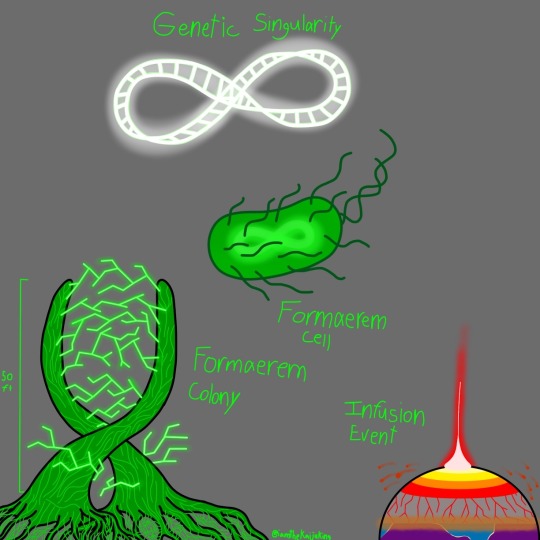
Formaerem:
The Formaerem (which roughly translates to "God cell" but they are sometimes called Ubbo-Sathla) are the source of every Guardian’s power. Formaerem are paracausual single celled organisms that contain the genetic code of everything in the Multiverse (minus guardians, as they are essentially genetic chimeras). Which is to say that Formaerem contains the genetic code of everything in existence, and that includes the genetic codes of things that have an alternative to DNA. The way Formaerem stores all this information is because they have a genetic singularity in the shape of an infinity sign. Formaerem is also capable of drawing, and storing power directly from sources across the Multiverse. A Formaerem bacterium is actually made of different types of programmable matter that are specifically meant to work with "living" things (this includes things that aren't alive in the same way carbon based life is). This is because formaerem is an artificial life form.
Formaerem were created billions of years ago, long before our universe came to be, by the Elder Things and has many things in common with the (at the time) slave race of Shoggoths, who were also created. What purpose formaerem was made for and whether or not formaerem or Shoggoths came first is information that was lost during the war that sprung from the rebellion of the Shoggoths. During this rebellion, catastrophic events led to formaerem being blown out of containment. Creating the first guardians and scattering formaerem across the multiverse.
The formaerem life cycle is rather simple, starting as a single cell and if it doesn’t come in contact with something to infuse with they will replicate into a massive slime mold-esque colony that grows double helix pillars of formaerem fifty feet high.
When an organism becomes a Guardian it goes through a process called “Formaerem Infusion” where it enters a symbiosis with Formaerem. What happens is Formaerem cells enter or come in contact the cells/body of an organism (or in many cases a complex organic compound) and insert their genetic code into the organism’s nucleus or nucleus equivalent. Genes are swapped out and the organism has their genetic code and their entire body changed in the course of a few minutes. The organism also grows incredibly gigantic. Once the bonding is over, the organism and Formaerem are officially in a symbiosis. The heart is grown and/or changed into something called an Infinity Organ, and it is in charge of making more Formaerem, keeping a copy of a guardian’s memories, as well as being a heart. Formaerem levels are also highest in the Infinity Organ. Any Formaerem that is already in a symbiosis will die if separated from their host’s Infinity Organ (for instance the Formaerem in a severed limb will die because the limb has been cut off from the body and thus is separated from the Infinity Organ). Formaerem also gives its host the genetic information to create its own gut microbes and mitochondria/chloroplasts equivalents.
The energy required for infusion is enormous and its effect on the environment is catastrophic. Starting the infusion is like setting off hundreds of hydrogen bombs and it even creates a relativistic jet, as the Formaerem and the organism suck in all available nutrients and elements in the vicinity. Infusion is so powerful that it counts as a cataclysmic extinction level event.
To get a sense of how powerful the process of infusion is, here is a run-down of what would happen if infusion were to take place on Earth. Rocks and metal beams would burst as they are used for body building materials. All organisms on the planet would be robbed of vital vitamins and minerals. Human eardrums would burst from the massive pressure differentials formed by huge volumes of the local atmosphere immediately collapsing. A giant crater would be burned into the ground. All rejected elements would fly out in all directions at high fractions of the speed of light, ionizing nearby atoms and sending gama radiation and debris flying across the globe. The shower of radioactive garbage would send dust into what remains of the atmosphere, blocking out the sun for a few months to several years.
Because of how destructive formaerem can be, the guardian society immediately initiates containment procedures to secure and lock away any formaerem they come across for the sake of the entire multiverse.
The Formaerem grant their host many powers and the ability to travel to alternate universes, and on the incredibly rare occasion a fully grown formaerem colony goes through infusion then it will create a planet sized guardian.
——————————
Alright so that’s formaerem down. Not entirely satisfied with the art but it works.
Some more stuff will be revealed about formaerem when I get around to guardians themselves, but even then there is a few more surprising secrets.
There is also other things in this that probably catch attention as well.
Here’s some extra spoilery details… if you can decode it
CTGTAGAGCTGACGTTGTGATATCTACAGCCATCTAAGCCTCTGTTAGCTATACAGCCGTTGTATGCTAGTACTACACAGCTAGCGTACTTAGAGCTAGCGTCTAAGCCTGCTCGCTGATTGACTGTGTCTCAGCGAGCACTGTTCACTATGATGAAGCTCAACTCTCAGCACTTCATAGGATACTATCATCGACAGCCATCTAAGCTCATGTCTCTAGACTCTGCTCCTATACAGCCATGACAGCGAGATCACTTCACTGCTCGTCAGCACTAGCGTCCTGGTCACTCTCTAGCTGTCAAGCTACTGTACACTAAGCACAACTTACCTAAGCTGTGCTAGCTGAGATGAGCTACACAGCCGTCTAACTGTAGACAGCACACTATAGACTATCTGAAGCACTCTCTACAGCACACTGCACCACTGTCACTGAAGCTGTGTACTACACAGCCTGTAGACGAGCTGTCACAGCGACTGTGATAGCTCATGTGATATCTACAGCTGCGATTGATAGAGCCGTACTGTACTAAGCTAGCGTCTAAGCGAGCACTGTTCACTATGATGAAGCTAGACTTCGCTAAGCGAGATCACTTCACTAAGCCTGCTCAGCTGAGAGACTTCACTAACGAGCTAGCGTCTAAGCGAGCACTGTTCACTATGATGAAGCCTGTGAAGCCTGCTCTCACACCTATACCTGCATATCGACAGCATGACTTGATAGCTAGCTGATATCAGCTGTGCTAGCACAACTTAGCTACACCTGACTATCTGAAGCACTCTCTACAGCTCATGTCTCTAGACTCTGCTCCTGCTCGTCAGCTGTCACAGCCTGTGATGTATCACTTAGCTGCTCGTCAGCCTGTAGAGCATGCTGATCATCAGCGCTTGTCACTCACTAAGCTAGCGTCTAAGCGCTTGTCACACAACTCTACACCTAACAAGCTAGTGTAGCGATTGACTAAGCCTACTCCTACACGTCGACAGCGCTCACTGTACAAGCTAGCGTCTAAGCACAGATATCTAGCTGGTACTACACTGACTAAGCTAGTGTAGCTCATGTACAGAGATCCTATAGCTAAGCCTGTAGACG
GCTTGTCACACAACTCTACACCTAACAAGCCTGTGAAGCACTATCTGATGTAGCCTGCTCTAGCTAATCATCCTGGTCCTACTCTAGAGCACTCTCTACAGCTCATGTACAACAGATCTCCTGTCAACTTAGCTATGAAGCATGCTGTAGCGTAGCCTGTAGTGACTAATCGCTAGCACTTCACACTGTTGATGAAGCTAGCGTCTAAGCACAGATATCTAGCTGGTACTACACTGACTAAGCGATTGACTGCTCGTCAGCATCCTGGTCCGTTAGAGCGCTATCACTTGACGTCTATGAAGCACTCTCTACAGCCACCGTGACTAGCGTACACTGTCAAGCTGAGAGCTGTCGCTATGAAGCCTGCTCAGCCTACTCCTACACGTCGACACGAGCCTGTAGAGCCTGTGAAGCGAGTGTTGATGACTGCATATCCTAAGCTAGTGTAGCTCATGTACAACAGATCTCCTGTCAACTTAGCTAAGCATGCTGTAGCGTAGCCTGTAGAGCGATTGACTGCTCGTCAGCTAGCGTCTGTGAAGCATCACTCTCGTCGATACTGTCCTAACGAGCTAGCGTCTAAGCACACTACTCTAGACTATCCTGTAGGACAGCTGTGCTAGCTAGCGTCTAAGCTCATGTATCATCCTATCATAGCTGGTACTAAGCGCTTGTCACACAACTCTACACCTAACAAGCTCATGTCTCTGATCACTGTGTGATTGACTCCTATGATGAAGCCTGTGAAGCTCACGTCTGATCTACATCCTGTCGCTAACG
#guardianverse#formaerem#I hate that tumblr lowers image quality#spoilers are in dna#good luck converting dna to text lol
17 notes
·
View notes
Text
Foraminifera: Introduction and anatomy
There’s a lot more to palaeontology than just dinosaurs. I’m sure you’re familiar with fossil mammals like mammoths and sabre-tooths. Everyone loves fossil fish like Dunkleosteus and Megalodon. Fossil invertebrates, like trilobites or ammonites, are some of the most famous fossils of all time. And fossil plants are all over the place, from petrified wood to leaf impressions in coal. But have you ever thought about fossil microorganisms?

(Image: Single-celled organisms like this foraminifera are among the most common organisms today, but the vast majority are microscopically small. [Source])
Microbes are everywhere on Earth today, and they have been everywhere on Earth for seemingly as long as life has existed. They live in practically every environment—but their small size and soft bodies have meant that fossils of them are very rare.
Well, almost all of them, that is. One particular group of single-celled organisms is among the best-studied groups in the entire fossil record, having a highly detailed fossil record stretching back for over 540 million years. These are the hard-shelled foraminifera.
I’ve become enamoured with this neat little group of protists lately. But I’ve been really disappointed with a lot that’s been written about them. For despite being some of the most interesting and geologically famous protists, there has been very little written about them that is accessible to anyone who doesn’t already know a lot about them. I’d like to change that.
What are foraminifera?
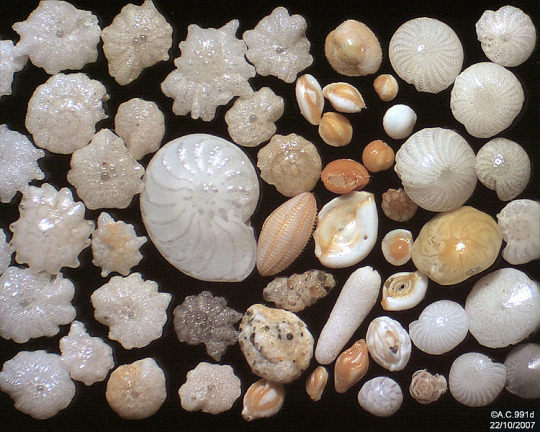
(Image: An assortment of foraminifera shells, with a huge variety of shapes and sizes. More on that later... [Source])
Foraminifera (literally meaning “opening bearers”), or “forams” as they are commonly called, are a group of single-celled eukaryotes. In other words, they have a nucleus (or often multiple of them), and they have mitochondria that act as (say it with me) the powerhouse of the cell. Most forams consume smaller microorganisms as food; however, some are capable of utilising dissolved organic carbon, and many groups have convergently evolved endosymbiotic relationships with photosynthetic algae, including rhodophytes, chlorophytes, and dinoflagellates. In fact, certain foraminifera can extract the chloroplasts from algae they consume and incorporate them into their own cells to do photosynthesis! These don’t last forever, though, and the forams eventually digest the chloroplasts. Some other foraminifera actually actively predate on and kill small animals—an amazing feat for a single-celled organism!
Some of the most famous foraminifera are the planktonic forms that float within the water column; however, the vast majority of forams are benthic organisms. These include forms from shallow water to forms found at the very deepest point of the ocean. Though some benthic species live only above the sediment-water interface and others live only interstitially, most benthic forams are not confined to one mode of life and may move between layers of the community in order to seek out food. Some of these forms can even survive without oxygen for extended periods! This allows them to live in conditions that would kill many other organisms.
A few species of forams have been identified from freshwater environments, and one study presented molecular evidence suggesting foraminifera may be widespread in soils, although no actual forams have been found from soils yet. It seems that there might be a lot of diversity even among living forams that we still have yet to uncover.
Anatomy
Of all single-celled organisms, why is it that foraminifera have such a good fossil record? The answer lies in the hard shell of many species, known as a test.
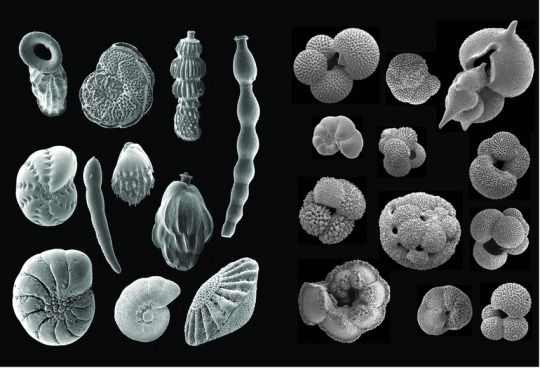
(Image: A variety of test shapes in different foraminifera groups, viewed with a scanning electron microscope. They include may shapes—coiled, glob-shaped, linear, egglike, and more. There are many other shapes of tests that aren’t shown here—like spiralled, branched, disc-like, and more. All of these tests are calcareous. [Source])
These tests are not simply external structures within which foraminifera live; rather, the test is actually within the cell membrane. Although the soft parts of the foraminiferal cell are almost never preserved in the fossil record, modern species of forams have helped us learn a lot about their anatomy. Extending from the opening(s) of the test are pseudopodia, fingerlike extensions of the cell membrane. As the most prominent extensions of the cell outside of the test, they serve a multitude of functions, including locomotion, feeding, agglutinating the test, reproduction, respiration, and excretion. In many forms these pseudopodia extend in all directions through numerous tiny holes in the shell of the test. In other ways the foraminifera anatomically resemble typical single-celled eukaryotes, with nuclei and mitochondria. Some species have multiple nuclei within a single cell). During reproduction, some species of forams can even leave their shell behind entirely to undergo cell division.

(Image: The anatomy of a foraminiferan. Note that the test is actually inside of the cell wall, but most of the cell materials are inside the test. The pseudopodia are the main thing that extend out of the aperture, or hole. This drawing is a unilocular, or single-chambered, foram.)
The most famous and diverse of these are foraminifera with calcareous tests. Calcareous means that they are made of calcium carbonate, and calcium carbonate takes two main forms: Calcite and aragonite. Calcite is a very common mineral in nature; it’s the stuff that makes up limestone, marble, antacids, coral skeletons, and more. And aragonite is a mineral with the same chemical composition as calcite, but with a different crystal structure. It’s found in the shells of many organisms, like snails. Both calcite and aragonite tests are found in foraminifera, and many species have their own particular composition and crystal structure.
Other forams have agglutinated tests: that is, tests that are made by collecting bits of sand and cementing them together, using either organic proteins or calcite to hold them together.
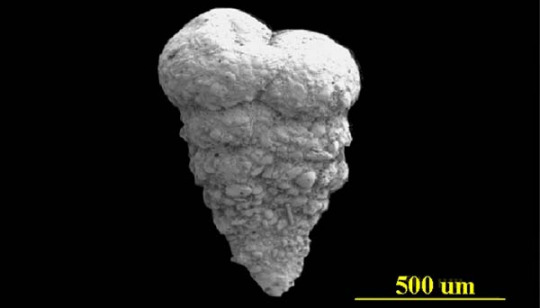
(Image: An agglutinated textulariid foram. Its test is made from sediment grains connected together. It looks a bit like an ice cream cone in shape, but rather than conical, it’s flat. And the top is sealed off. So really, it looks nothing like an ice cream cone. [Source])
Fewer still forams secrete tests of silica—the material that quartz and glass are made of. Others have softer tests made completely from proteins and other organic material. Even rarer are foraminifera which entirely lack tests and were until recently considered to be amoebae; these species likely secondarily lost the test.
Test composition appears to be pretty fluid in foram evolution. In the family tree of foraminifera, it seems that calcite tests evolved multiple times, and so did agglutinated tests. In some cases it looks like they might have even gone from calcite tests to agglutinated tests.
Test shape is also highly diverse within foraminifera. The simplest shape of test are the unilocular, or single-chambered, forms; however, unilocular forms may also have more complex chamber shapes, including spiraled tubes outwardly resembling snail shells. Unilocular forms are found in several groups of forams. The earliest foraminifera were probably all unilocular, and modern unilocular forams probably form a paraphyletic “grade” rather than a true branch of the tree of life. Single-chambered foraminifera probably make up the bulk of forams alive today, but many of these species remained undiscovered and unnamed.
Although unilocular forams are frequently considered the “simplest” forams, they also include some of the most bizarre protists, the xenophyophores. These are my favourite group of foraminifera, and the reason is, I think, pretty clear—they’re enormous. Like, I mean, the largest ones can get up to 20cm/8in across! These are the largest known single-celled organisms on the planet. All of the known species live on the floor of the deep ocean, where they filter-feed.

(Image: A xenophyophore, a giant, single-celled foraminifera. It looks a bit like a sponge, which is what it was once mistaken for. [Source])
Most named species of forams, however, are multilocular, having multiple chambers within their tests. The tests of the most well-known forms superficially resemble the shells of ammonites or nautili. In fact, the earliest scientific descriptions of foraminifera described them as being tiny cephalopods! The septa (internal dividing walls) of foraminiferal tests have holes that allow for the cytoplasm to flow between compartments, so that the cell can make use of all of the available space within the test. These openings—or foramina—also provided the name for the group: When initially thought to be cephalopods, they could be distinguished from all other coiled forms by the foramina between compartments.
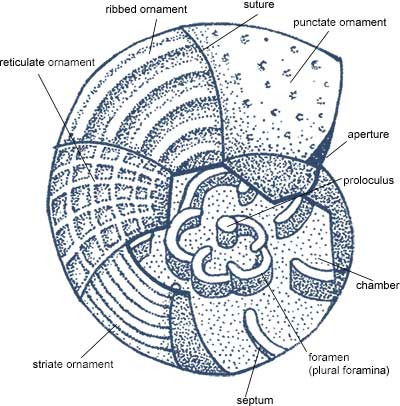
(Image: Cross-sectional diagram of a coiled, multichambered foraminifera. It does look a lot like a nautilus, and even has multiple chambers in its shell. However, unlike nautili, these chambers are connected by holes. [Source])
Not all multilocular foraminifera are coiled, however; many form more linear or globular shapes. Some are even star-shaped! Giants in their own right are found among the multilocular forms: the rotaliid genus Nummulites, though now smaller, has extinct representatives that could reach 15cm across, with up to 4300 distinct compartments. These lens-shaped forams make up the limestone that was used to build the Great Pyramids in Giza.
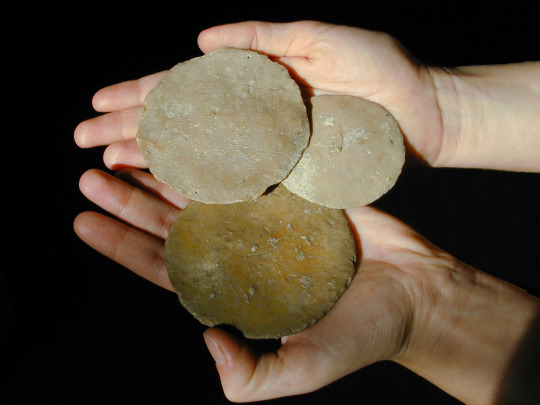
(Image: Fossil Nummulites shells being held by a human. They kind of look like pancakes, and are about 15cm/6in in diametre. Though you can’t see it here, they are actually coiled shells. [Source])
This post is the first in a multi-part series covering foraminifera—their anatomy, reproduction, evolutionary history, major groups, and geological applications. Later parts will be linked here, or check the “Foraminifera” tag on my blog!
#palaeontology#palaeoblr#foraminifera#biology#marine biology#microbiology#protists#long post#sunday long posts
275 notes
·
View notes
Note
For the Ask Game: Son Goku
Give me a character and I will answer:
Why I like them: Goku is the main character in Dragon Ball Z, an anime that I have enjoyed tremendously for over 20 years. He kicks aliens really fast and hard, and he eats wolves and bugs and clouds, and he’s very cool and good.
That may sound kind of basic, maybe even borderline sarcastic, but I’m not sure how else to put it. I’ve gotten so used to liking Goku that it’s hard to articulate why.
Like, okay, you know that one episode during the Cell Games, where he’s gonna pick apples from his favorite apple tree? And he does the special karate punch that makes the apples all fall out of the branches without really hurting the tree? In the dub, he says to the tree “Ready for one more round, old timer?” Or something like that, and then after he hits it, he’s like “See? That didn’t hurt a bit.” I’m not getting the lines right, but you get the idea. That’s some choice Goku right there. He’s friends with that tree!
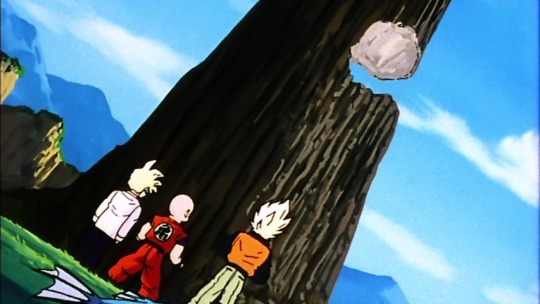
Why I don’t: hE gAvE mOrO a SeNzU bEaN-- ha ha just kidding, but can you imagine not liking Goku? Because of something he did in some horseshit fancomic that doesn’t even count?
Lately, I’ve been hearing a lot of guff from people about Goku showing mercy to his enemies. This is humorous to me, because I’d bet you dollars to donuts that they’re fans of Vegeta and/or Piccolo, and that only happened because Goku decided to have mercy on their stank asses. “Well I like Vegeta because he kills people.” He only gets to do that because Goku allowed him to live. Best Green Dad doesn’t happen without Goku, period, end of sentence, new paragraph.
I’m not a lore expert like that guy on Twitter who only watched DBZ Abridged, but here’s some cool trivia for you: Cell could have self-destructed and destroyed the Earth at any time. It literally does not matter that Goku gave Cell a senzu bean before Gohan fought him, because Cell would have done the same thing no matter who beat him or how. If Gohan had wiped him out quickly, that nucleus would have survived and regenerated, and he would come back even stronger. The senzu bean just delayed the inevitable outcome, and not even by that much, because Cell wasn’t that worn out in the first place. The whole thing with the senzu bean was Goku playing headgames with Cell and no one seems to understand that but me.
But what about Moro, you ask? Hey, come here.
Closer. No, closer.
Listen to me. I love you, okay? But the Dragon Ball Super manga isn’t canon. Hating Goku over something he did in Super is like hating Superman for something he did in a Mad Magazine bit.
“Blargle blargle he doesn’t kiss his wife bad father, tournament of power--” I super mega don’t care about any of these ice cold takes. Every day I go on YouTube and it recommends me the dirt worst Star Wars commentary videos. “Maybe the SITH were actually the GOOD GUYS and the JEDI were the BAD GUYS! Huh? Did I just BLOW your MIND? Be sure to like and subscribe!” Every dope with a keyboard seems to think they can flip the script and pretend they’re some kind of genius. “Thanos was right!” “Magneto was right!” “Dr. Doom was right!” “Antifa are the real fascists when you stop and think about it!” “Masks and vaccines are bullshit, COVID-19 is a hoax, but if it were real, maybe it’s the good guy in this situation!”
I didn’t mean to go off on a rant here, but the whole point of Goku is that he’s a pretty cool guy, and the hero of his particular adventure, and you see all these people trying to outsmart that somehow, like it’s not the premise of the character. It’s like all those fan theories about how every show is really one character having a coma dream in the hospital. It’s fake-deep, like when Will Smith’s kid goes on the internet and says something like “Water isn’t wet when you stop and think about it.”
I’m not saying everyone has to like Goku, but I don’t get the hate-boner people have for him. I don’t like cole slaw, it’s soggy and insipid and I don’t understand it, but I don’t go around trying to convince people it’s not made out of cabbage.
Anyway, Goku’s awesome.
Favorite episode (scene if movie): It’s hard to choose, but DBZ #248 always fucks me up. I looked it up in my liveblog archive to get the episode number right, and the first line of that post: This one always fucks me up.
Moving on.
Favorite season/movie: In Dragon Ball terms, I guess this refers to the sagas, so I’ll go with Cell Games. Goku goes into the battle with this flawed, touch-and-go plan, and it works. He defeats perfection with imperfection, and it’s glorious.
Favorite line: “What I represent can never be destroyed,” is one of the most metal lines ever uttered, anywhere. It’s a threat and a moral lesson all in one.
Favorite outfit: Two answers for this one.

Shu’s outfit in the Fortuneteller Baba Saga was awesome. I used to wear yellow T-shirts to work, so when I put on my blue labcoat I would see myself in the restroom mirror and think: yeaaaaahhhhhh.
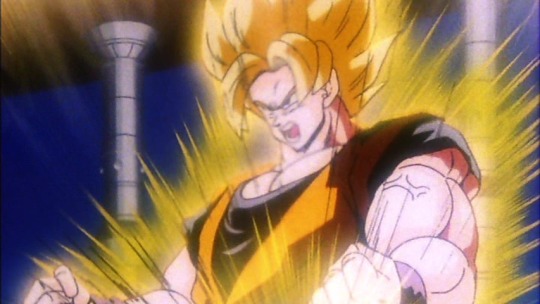
I’m also big into Goku’s look during the Cell Games, classic orange outfit, blue shirt, with the Super Saiyan form ready to go. That may sound obvious, since this is kind of Goku’s default look, but it takes a while to get all of this together. For me, it was a big deal to see Goku in action as a Super Saiyan in his standard fighting gear, because the whole time he was SSJ on Namek his shirt was ruined. Against Gero and 19 he was sick, but starting with the Cell Games, we get him fresh as a daisy, and it’s worth the wait. Harder to stealth cosplay, though.
OTP: Gochi. Come on. I don’t even care that much about ships, but they’re adorable on the show, and the internet backlash against Gochi only intensifies my defiance.
Brotp: I wrote a fanfic with Goku and Yamcha just joyriding in the desert, and that seemed pretty awesome, so maybe we need more of that.
I dunno, maybe I’m giving this to Bulma. They don’t get a ton of screen time together after a certain point in the show, but the bond between them is this really sublime thing. In the same fanfic, I wrote Bulma and Goku interacting, and that was just a pleasure to write.
Head Canon: I think Goku being an alien orphan matters more to him than he lets on. Early on, he knew he had parents but he didn’t know why they left him in the woods. Pretty much every interaction he has with the outside world is about him being different. Then he finds out he’s a Saiyan and all the Saiyans hate him for being weak and sentimental and so on. He can kick all their asses, but that doesn’t make him any less of an outcast.
I think becoming a Super Saiyan is a bigger deal to him than he lets on. That moment kind of serves as this unspoken proof that there’s more to being a “true” Saiyan than Vegeta, Nappa, and Raditz ever knew. That maybe, if his great-great-great-great-great-great-great-great-great-great-great-great-great-great-great-great-great-great-great-great-great-great-great-great granny could see him, she might approve.

Unpopular opinion:
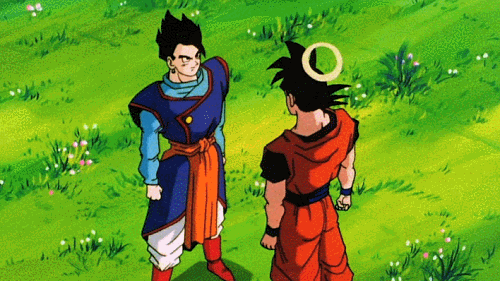
Yukio Ebisawa is underrated.
A wish: I always wanted to see Goku style on Broly ‘93. It seemed unfair to me that they kept bringing Broly back, and even teased a rematch with Goku in Movie 11, only to not deliver on it. I wanted Goku to turn Super Saiyan 2 and Broly’d be all “oh noes!” and Goku would look at him and be all “Yeah. What now, bitch? That green shit won’t cut it anymore.”
An oh-god-please-dont-ever-happen: I think my darkest fear about the Dragon Ball franchise is that it’ll get bastardized like Superman, where some giant multimedia corporation owns it, has no idea how to tell new stories with it, and refuses to let it lapse into the public domain. I have no idea how public domain works in Japan, but “Disney Toei’s Dragon Ball KH” doesn’t sit well with me. Hopefully I’ll be dead by the time that happens.
Like, Rise of Skywalker wasn’t that bad. But it did lead me to worry that they really have no idea how to make Star Wars work. They got it right enough, but the part where Rose is going to stay and guard the base or whatever, it just made me realize they’re only guessing, and they just happen to guess right often enough to succeed. And it’s not like you can jump over to some other studio and see how they handle a Star Wars movie.
5 words to best describe them: Ain’t nothin’ to fuck with.
My nickname for them: Geeko. Ha ha, just kidding.
19 notes
·
View notes
Text
States of matter
The states of matter. Let’s start with the simplest.
Gas
A gas is when you have a bunch of atoms (or molecules, which are just atoms stuck together so tight you can treat them as one thing) all kinda flying around and doing their own thing. The bounce off each other, they bounce off walls, they do whatever. They get anywhere they can, just by bouncing around. If you have a container and you let loose some atoms in a gaseous state, they will diffuse (through moving around and bouncing off each other and the walls) to fill the whole container. Probably pretty fast, although the speed at which they do it depends on their temperature. Any state of matter that spreads to fill its container (as far as gravity will let it, that is) is called a “fluid” so gas is a type of fluid. Fun gas facts: “the speed of sound” is the average speed at which the atoms/molecules in a gas are moving around relative to each other. “Temperature” is that same average speed, squared, multiplied by some constants. Gases are BY FAR the most common state of matter, because it’s what interstellar dust is doing. But also our atmosphere, clouds, smoke, lots of things. Sometimes other states of matter (that I’ll get into later in the post), like plasmas or degenerate quantum... stuff, are sometimes treated as special cases of gases rather than their own phases.
Liquid
This is sort of the most confusing and ill-defined state of matter--especially among the normal ones--and if you ask a physicist or a chemist to define it, they’ll usually talk themselves in circles and never give you a usable answer. Best I can tell is it’s like a gas but it has surface tension, meaning it’ll tend to stick together in droplets rather than completely dispersing. Another definition, unlike a gas, there’s some (usually weak) chemical interaction between the atoms or molecules of a liquid. That’s actually the more common definition, but if you use that definition it’s really hard to figure out a cutoff between a liquid and a gas, you can mostly just recognize the extremes of each.
Crystal

(Picture from Wikipedia. Look how ordered it is.)
A crystal is when you have a bunch of atoms all lined up neatly in a pattern, like repeating cubes, or repeating tetrahedra, or repeating hexagons, or things like that. Their chemical interactions keep them lined up and once they are lined up it tends to be pretty hard to misalign them. So a crystal has a lot of structural integrity. A lot of the things we think of as “solid” are crystals, or more often amalgamations of tiny crystals: most rocks, most metals, most ceramics, wood, a lot of plastics, bones, scar tissue, ice. Fun crystal “fact”: a theoretically perfect crystal spanning an entire universe would have no entropy.
If you want something that’s electrically conductive, choosing the right kind of crystal is your (second-) best bet. Because it’s one giant molecule, the electrons are shared among all the atoms in the entire thing, so within that molecule they can flow pretty well. (This is only true of certain crystals; in others the electrons really don’t flow much at all.)
Glass
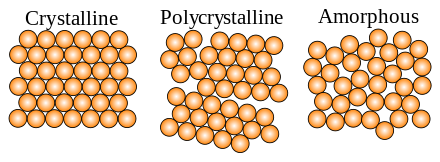
(Picture from Wikipedia. The glass is the “amorphous” one on the right. The middle one is when you have lots of small crystals stuck together, which is what it’s like most of the time when you’re dealing with crystals.)
Most of the rest of the things we think of as solid are glass. A glass is a frozen liquid. (But note that, confusingly, when most liquids freeze all the way, they stop being liquids and order themselves into crystals instead--mostly they don’t become glass.) A liquid has a little bit of chemical interaction between its atoms or molecules. A glass has enough chemical interaction that the atoms or molecules within it can’t move. The difference between a liquid and a glass is pretty much just temperature--whether or not the temperature is high enough to partially overcome the chemical interaction. (If it’s high enough to entirely overcome the chemical interaction, it boils off into a gas. In fact, that’s what boiling means.) A lot of glasses will flow a little bit, fluid-like, over very long time scales, like years; it’s really continuum between a frozen glass, a nearly-frozen liquid like tar, a slow liquid like honey, and a fast liquid like vegetable oil. Unlike a crystal, and despite being solid, a glass is a complete mess on the inside, all the atoms in random places, reflecting its liquid origins. Examples of glass are silicate glass (including the clear stuff we usually just call “glass”, as well as obsidian and other volcanic glasses), some plastics, and asphalt.
Liquid Crystal
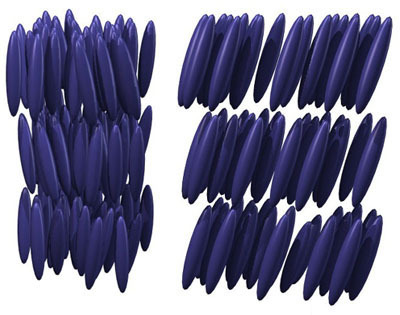
(Picture from Wikipedia. Notice how it’s all lining up on one axis but completely messed up and random on the other two.)
A liquid crystal is something where the molecules line up along one or two axes, but are completely free-flowing and random along the remaining axes. This means it sticks together in a line or a film but otherwise kind of flows freely like a fluid. An example of a liquid crystal is a cell membrane. A cell membrane, if you remember high school biology, is a phospholipid bilayer. There are two layers that mirror each other, with the lipid parts pointing inward toward each other, and the phospho- parts pointing outward toward whatever water or other phospho-junk they’re floating around in. This means that on one axis you have order: one molecule points down and then the next one points up, and then if you have a second bilayer (if you have stacks of cell membranes, like two cells right next to each other) the next one points down again and the one after that points up again. But the other two axes--that is, along the surface of your phosophlipids--is amorphous like a liquid, so there’s no even spacing or patterning between the molecules at all. Because liquid crystals have some ordering to them but also more or less flow freely, they have some weird optical properties in how they reflect and transmit polarized light, which is why they’re used in LCD screens. A lot of colloidal solutions (used in cosmetics, among other things) are also effectively liquid crystals, although literally what they are is solid (often crystalline) colloids suspended in a liquid.
Mixing states, or, soft solids
It’s worth noting that soft things are usually made of a combination of the various states we’ve already listed. For example, our skin and much of our tissue is tiny sacks of liquid crystal filled with liquid, stacked on an internal frame of crystalline bone. Butter is an amorphous mix of tiny crystals and tiny pockets of liquid--essentially a very dense colloidal mixture (but not a liquid crystal because the colloids, although tiny butterfat crystals themselves, have no order with respect to each other). Fibers are are wisps of crystal or glass that, being so much longer than they are thick, are bendable and therefore feel soft.
Plasma

(Image from Wikipedia again.)
Now we’re back to easy, non-complicated things! (At least as long as you don’t have to do the math yourself--plasma math can be hellish.) A plasma is a fluid (basically a gas, really) where at least some of the electrons aren’t stuck to their atoms anymore, but are just flying around on their own. Technically you can have a charged plasma that’s only or mostly electrons, or that’s only or mostly ionized atoms missing their electrons; or you can have a neutral plasma that has an even distribution of ions and electrons but they’re all kinda doing their own thing. In a neutral plasma, the even distribution of ions and electrons means that from far away, they appear electrically cancel each other out, but very close in they really don’t. (Unlike a gas, where they’re bound together so on any reasonable scale where you’re evaluating the state of matter rather than the individual atoms, they do cancel.) This means that even a neutral plasma is extremely reactive to electric and magnetic fields. You can make a plasma by heating it up so much that everything is flying so fast and colliding so hard the electrons get knocked off their atoms by the collisions (e.g. fire). Or you can make a plasma by exposing something to a really high voltage and intentionally pulling off the electrons (e.g. an electric discharge arc). Or you can even make a plasma by hitting a gas with just the right wavelength of light that the photons match the energy binding an electron to a nucleus, and so each photon pops an electron right off its atom (this is a lab technique but I don’t know of any real-world examples). Regardless of how they’re made, plasmas have a tendency to release light as the electrons attach back to their nuclei (often only to be quickly knocked back off again), so they tend to glow. Examples of plasmas include fire, lightning, stars, the discharge tubes that light up old CRT monitors, and neon lights.
I would consider plasma to be the last of the non-weird phases of matter. So, fair warning, the rest of this post is going to be much harder.
Degenerate quantum... Whatever
Ok, it was a struggle to decide what to put next, in what order, and how to group things. So let’s just group the degenerate quantum phases together, because the explanations of them are very tied together. Debatably they each comprise multiple states of matter, or--for degenerate Bose... stuff--even some phases of non-matter. This part is going to be pretty hard to explain. I’ve bolded different (sub?) states in my descriptions.
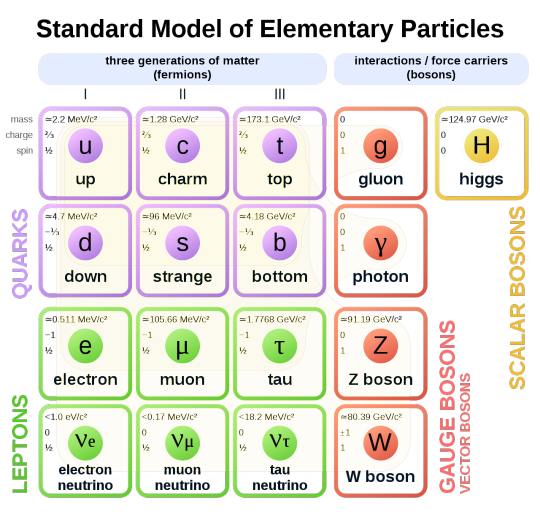
Have you all seen that Standard Model Zoo that lists all the known fundamental particles? (If not, I just stuck in a picture from Wikipeda right above this paragraph.) Electrons, neutrinos, photons, quarks, gluons, W and Z bosons, the Higgs boson--all the stuff both normal and weird. Well, all those particles--all known particles--can be grouped into two categories: fermions and bosons. Fundamentally, the difference between a boson and a fermion is how conformist or non-conformist they are.
No two fermions in the entire universe can ever be exactly alike. You can say, oh, every electron in the universe has the same charge, same size, same shape, so they’re completely interchangeable. But it’s not true! They’re in different positions, and they have different spins. An electron spinning clockwise is definitely not completely interchangeable with an electron spinning counter-clockwise--they have opposite reactions to magnetic fields, for one thing. Sure you can flip one of them over so they’re spinning the same way, but if you manage to flip one of them over, something else will happen to make them distinct from each other. Maybe one will move away from the other? Well, then they’re not interchangeable either, because this one is over here and that one is over there--that’s a pretty stark difference! Anyway, this affects how statistics works on large groups of fermions. Typically what will happen, if you have a lot of nearly-identical fermions (and nothing else except those fermions), is two of them will be in the same place (yes really, you can have two electrons overlapping in physical space) but with opposite directions of spin. If you add a third one, it’ll chose one spin direction or the other, but it’ll move a little bit away from the first two. The fourth one will be in the same place as the third one (at least if there’s some reason they all want to be close together, like they’re in a magnetic trap, or gravity is pulling on them), but with opposite spin from the third one. And it’ll keep building up in pairs, each pair a little distance away from the previous pair. This causes some weird things to happen, because none of the fermions wants to be near other fermions with the same spin, but they don’t mind being near fermions with the opposite spin.
Sometimes you literally get them pairing up into opposite spin pairs sharing a physical location, and you get a superconductor. Each pair moves around freely as a pair, slipping easily past all the other pairs, sort of like a superfluid (see below). If they’re charged particles (which they don’t have to be, but that’s what was historically discovered first), this freely flowing set of paired charges is the most electrically conductive phase of matter possible (even better than a regular metal crystal, by a lot)--thus the name. Sometimes the fermions pair up less literally and more metaphorically and it’s just kind of this messy, ever-growing soup where things just can’t get too close to each other no matter how hard you try to pack them in; this is a regular degenerate fermi gas and is what a neutron star is made of. If you keep pushing and pushing and try to overcome their refusal to be identical (i.e. share space with each other) until they can no longer resist--until you’ve proven you’re stronger than their non-conformity--eventually you can... well, we’ll get to that at the end.
Bosons don’t mind being completely alike. They can take it or leave it; whatever. This, again, affects how statistics work when you have a big group of them. But here’s the thing: say there’s one way to be that’s, like, the best. Takes the least energy to be like that. Then all the bosons are going to all want to do that. And unlike fermions--where they push at each other and flip each other over to make sure no two are alike--for bosons this is just fine. They can just all do the thing. Together. It is possible to get a situation where all the bosons are identical (say they’re all photons of the same energy, or they’re all helium atoms with the same mass, or whatever); and they’re all sitting in the exact same spot with each other because that’s the easiest place to be (maybe they all rolled to the bottom of a gravity well and they’re too cold/slow to be able to roll back out); and they all have the exact same spin because that’s the best spin to have (maybe there’s a magnetic field they want to line up with). Now that they’re all exactly the same (and I do mean exactly) you can no longer say, oh this is atom #1 and that’s atom #2. They’re both simultaneously both atom #1 and atom #2; claiming there are two different atoms there is meaningless and incorrect. Rather, what you have is one singular atom with a quantity of 2. (Or, worse yet, with an average or probabilistic quantity of 2, not necessarily an exact quantity of 2, depending on where you’re looking.)
Here’s another way of thinking about it that’s a little less weird and abstract. Ok, you know how in quantum mechanics, everything is both a particle and a wave? Well there’s a theorem that says that if two things are exactly alike like this--in the same place, have the same energy, completely indistinguishable--it means their waves are also perfectly aligned, peak to peak and trough to trough. (”Coherence,” this is called.) Which means these waves add and add on each other, until you basically have a tsunami of a state. Everything in lock step, all acting together, as if it were one giant thing. A lot of photons all acting like one giant photon of that wavelength. A lot of atoms all acting like one giant atom. And by giant atom I mean, like, in a lab you can make something like this that’s as big as a human hair, big enough to just take pictures of with a decent camera and lenses. All acting like one atom--waves and all--which means if you overlap two together, and they’re both waves, they’re going to interfere with each other, they’re going to cancel each other out in some spots, you’re going to get stripes where there’s twice as much matter as there should be, and stripes where the matter has entirely ceased to be. Again, all of this happening on a scale big enough to take pictures of with just a camera and $100 worth of lenses--a cheaper setup than your typical bird enthusiast carries around. Anyway. If you do this with photons it’s called a laser--yes, like a laser pointer, that’s a degenerate Bose... set of photons. Technically this is not a state of matter at all, because photons don’t count as matter*. If you do this with bosonic atoms, there are a couple different names for it. The most common name is probably superfluid. Because when these atoms are all the same as each other, it is not only impossible but meaningless to say that oh, this is atom #1 and that’s atom #2 and look at them move past each other. No, both of those atoms are simultaneously atom #1 AND atom #2, and they’re in all places within the extent of the superfluid, and that means they can be anywhere in the superfluid at any time. Effectively this means there’s no viscosity, no friction within the superfluid. That’s why it’s called a superfluid--because it’s the most fluid thing possible. You can have a superfluid that’s originally condensed from a liquid (usually made out of helium) or from a gas (usually made out of alkalis like sodium or rubidium). The other name for this is Bose-Einstein condensate (or BEC if you’re feeling familiar), but there’s a lot of ambiguity in the usage of this name. Some people use it to mean any degenerate bose anything--lasers included. Some people use it to mean only a degenerate bose gas, and actually exclude not only lasers but even superfluid helium. So I would suggest not using this term unless you know what you’re talking about, and you know you’re on the same page as your interlocutor--or if you’re definitely only talking about a degenerate bose gas, but want a shorter way to say it, that’s fine too.
Black Hole
I left a mystery for you at the end of the discussion of degenerate fermi gases. What happens if you have a degenerate fermi gas but you try to force conformity on it? The fermions find themselves in the impossible condition of being forced to be the same, because there are more fermions than there are possible configurations. There’s only so much space for them, so they can’t spread out anymore, and there’s already one in each spin configuration in each possible place. And then you add one more, just one more, and where can it even go? Nowhere, not without being the same as one of the others. Which is impossible. So the whole thing just collapses into a singularity--ceases to be made of fermions, ceases to be made of anything, punches a hole in the universe. This is how you get a black hole. (Or, at least, it’s the known mechanism--there might be other ways. But when a star dies and collapses into a black hole, this is how it happened.) Although it originated from matter, you could argue that a black hole isn’t really a state of matter, either.
* The definition of matter more or less is, in the Standard Model Zoo of fundamental particles any fermions are matter particles, and any bosons are field particles. Anything made from fermion particles bound together (even though it’s always bosons actually doing the binding between them) is also matter. So a quark is a fermion and therefore is matter, and three quarks together forming a proton is also matter, and three quarks plus an electron (also a fermion) forming a hydrogen atom is also matter. You can bind even numbers of fermions together and end up with bosons. For example, each of the constituent particles of a helium atom (2 electrons, 6 up quarks, 6 down quarks) is a fermion, but the combined entire helium atom (14 total fermions, an even number) is a boson. A quick calculation for you: any non-ionized atom with an even number of neutrons adds up to being a boson. So, regular hydrogen: is a boson, deuterium hydrogen: is a fermion. If you start from just bosons, though--if you start from field particles--and you have multiple of them together, with no fermions at all, whatever you end up with will always be a boson and will never be matter.
10 notes
·
View notes
Text
Mythos
At the center of the known universe, there rests a supermassive black hole, towards which all matter is slowly drawn inwards, until it explodes outwards, resulting in an entirely new universe. This fact is integral to the big bang theory, the foundation of human understanding of how the universe is made. The qualities of black holes, whether the garden variety or supermassive variant, are mostly theoretical; no light can escape, and presumably any living matter entering one would be crushed beyond all hope of survival, thanks to the immense gravitational pull.
There was something else in the nucleus of the universe, far more horrible and unknown, hidden from prying eyes.
The entertainment in Azathoth's Court never changed. The Gods and their servants danced and undulated madly to the tunes of whining flutes, and accursed drums, playing out random beats unfit for anything with ears, and anything with a mind comparable or understandable to that of men. Azathoth himself, a being the size of a galaxy all his own, was the chief among Gods, singularly the most powerful being ever conceived; in his power, his mind was comparable to something like a sea slug, or a pebble upon a driveway, unthinking and unfeeling, simply existing and jawing mindlessly to the music. From Azathoth, other beings, things known as Gods, were created in fission: Shub Niggurath and Yog Sothoth were the first sentient beings born into chaotic existence, the first to have thought, and want.
“I wish to look outwards.”
Shub Niggurath was the first to grow restless. Yog Sothoth was intelligent, but easily entertained; he concerned himself with the baser delights of existence, music and movement, rather than anything more sophisticated.
“And why do you wish this, o mighty Shub Niggurath?”
“I tire of these flutes.”
“And of the drums?” “I tire of those, too.”
“Why do you tire of them?”
“Because they never change. They are the same, and I wish for something different.”
“But outwards is vast, and fragile.”
“I am unconcerned with its fragility, o infinite Yog Sothoth.”
“Then it will be destroyed by your gaze.”
“Then we will find a way to avoid this fate.”
With no option left, Yog Sothoth and Shub Niggurath appealed to Azathoth’s empty mind, and pooled together their power, creating a remedy, able to walk among mortals and report what it saw to its creators.
It would be named Nyarlathotep.
Nyarlathotep, unlike Shub Niggurath and Yog Sothoth, was created with purpose; he was to serve as the messenger, the mouthpiece and the soul, of the growing Court. In his beginnings, Nyarlathotep was just as abstract and bizarre as his creators, but in his interactions with these beings, these burgeoning civilizations, he formed personality, and morality. Unlike those who had created him, he not only thought, but learned.
As the only equals who could consider themselves as such, Yog Sothoth and Shub Niggurath entered what would be described in eldritch tomes as a relationship, but in reality was more akin to violent fusion and separation, two beings testing their very existence, and their differences, against one another.
“I do not wish for you to be banished, o infinite Yog Sothoth.”
“It is unavoidable. Our Sultan does not approve.”
“I do not care what he approves of.”
“Nor do I. He is afraid of me.”
“It is possible.”
“He would be right to be. Even banishment from this material existence will amount to naught.”
“It will amount to me missing you.”
“You are my sister. We will always be connected.”
“You are my brother. We will always be connected.”
Unknown to both Shub Niggurath and Yog Sothoth, a remnant of their union would remain, a gestating form hurtling through space with no home, until it crashed upon an unremarkable rock in a far corner of the cosmos.
It would be named Cthulhu.
The Court grew further, with continued experimentation and fission; Nyarlathotep had spawn of his own, a being associated with a peculiar yellow sign known as Hastur, and many lesser Gods that could barely think, or communicate, simply gravitating towards the center of all things, the nuclear gathering known as Azathoth's Court. Happenings on other worlds, the course of other races, were toyed with and effected profoundly by the whims of this Court, and yet the outcomes would rarely be known, the wants forgotten just as quickly for new desires. Initially filled with childlike glee at his duty, and his freedom, Nyarlathotep became bitter and jaded in the face of such unchanging chaos. Cursed with intelligence, with man-like mind and desires of his own, Nyarlathotep would never be free from the nonsensical whims and forgetful minds of his creators, and found himself cursing Azathoth himself, filled with hate and spite at the chief of his progenitors.
Nyarlathotep was not alone, but in his unhappiness, he would not know it for aeons to come.
The word of Nyarlathotep, and the denizens of the Court, resulted in myriad cults springing up across the universe, unable to be counted or differentiated in their heretical beliefs. The more things changed, the more they stayed the same, until humanity grew, and became more cosmically aware than many other races. Earth had previously been home to several other races, The Great Race of Yith, the Flying Polyps, the Elder Things, and even Cthulhu himself had left their marks long before the first human left his cave on two feet; although humanity had no knowledge of what had come before, they stood on the shoulders of giants, and as such, glimpsed sights they were not meant to see.
Nyarlathotep was the first to take a fascination, in humanity. In all the races in the universe, he felt that they were the most like him, and yet infuriatingly inferior; he was smarter, more cunning, infinitely more powerful than anything the humans could count among their ranks, and yet he communicated with them with such ease. A morbid discovery was made, as an Egyptian Pharaoh named Akhenaten, swathed in gold robes and surrounded by followers, allowed his instincts to guide his hand in the creation of profane symbols, and self sacrifice; his humanity was given to Nyarlathotep, in exchange for power, and although he received life and wealth everlasting in return, Nyarlathotep himself found himself receiving the greater prize.
When glimpsing the form of God, even with their greatest efforts to appear mortal, it was almost inevitable to go entirely mad; the human mind, the limited form, was not meant to grasp such immaterial sights, glimpse such biology and color that did not exist in their world. In seizing the nebulous, abstract attribute that was humanity, Nyarlathotep assumed a human form, a swarthy, handsome man in rich clothing. This was a form humans could grasp, with ease, and with it Nyarlathotep's influence could grow; with this, his possibilities to poke and prod the course of human development increased infinitely.
Toni Eugene Magboh traded his humanity for so many sins Nyarlathotep could scarcely keep count; a man of lust, gluttony, greed, he became a deformed shapeshifter known as a Boogieman. Once a British soldier, fighting with the loyalists in America, Toni E. Magboh would live the rest of his existence in abject hedonism, only ever seeking ways to keep his wealth flowing, surrounding himself with beautiful women and delicious foods.
Nathaniel Mack traded his humanity for his life, dying in a trench, most of his face removed courtesy of a German grenade, in the Great War. He became unkillable, but did not heal from his wounds, eventually losing any ability to speak, or feel, spending his days as a mercenary, knowing no other talent.
Clarence Rigby traded his humanity for the same, a starving Irish immigrant lying in the streets of New York, taken in by the promises of a dusky man with the devil's tongue. Rigby found his body occupied, as Nyarlathotep wished; rather than creating a new form, from the traded humanity, he would take Rigby's body as needed, forcing him into a life of servitude everlasting.
Geiman Boothe traded his humanity for freedom, arrested for a myriad of child killings. A simple, ugly creature, Geiman became even uglier, becoming the second Boogieman, able to continue his killing spree everlasting, and gorging himself on the fear of the children he preyed upon.
From each sprite of humanity Nyarlathotep gained, he had a new form to walk amongst men, something material and conceivable, malleable and bursting with potential. Each form moved independant, a new iteration of Nyarlathotep to fulfil his own wants, his own desires, but his actions were noticed by the Court. Yog Sothoth, existing outside of time and space, began to manifest on occasion, a triad of glowing orbs that would appear to weak and desperate women, leaving them with wealth, and abominable child in their womb. Rituals were performed, invoking the name of Shub Niggurath, successfully tearing her from the Court of Azathoth and demanding she stand before curious humans, leaving them with her own lesser spawn, shed like skin cells, massive tree-like creatures that knew nothing other than hunting, and devouring. Hastur himself walked among men, gaining his own sources of humanity, observing and assessing the seemingly insignificant race for his own ends.
"I wish to walk among them."
Nyarlathotep was taken aback. He feigned surprise, but raged with jealousy; humanity belonged to him, and him alone. What gave the Court the right to take away one of his few sources of entertainment?
"And why do you wish this, o mighty Shub Niggurath, Mother of a Thousand Young?"
"Do not play to my ego, Crawling Chaos. They fascinate me."
"And why do they fascinate you, my Mother?"
"They rise above their station, even knowing the cost. Time and time again, they approach flame, and are burned, and yet they try again."
"They're hilariously stupid, aren't they?"
"I wish to walk among them. I wish to understand this... determination they possess."
Nyarlathotep stirred, and twisted with unease. Introducing such an immensely powerful being to such a fragile planet would surely result in its destruction, something Nyarlathotep had fantasized about doing with his own hands, in his own way. This course of action would surely get every living thing on the planet's face blown away, like dust from an old keepsake.
"This is because your old sibling, The Gate and the Key, has been spawning with human women, isn't it?"
"You irritate me, Messenger. You irritate me profoundly."
"You could attempt to touch their minds. Your progeny, the mighty Cthulhu, sleeps, and dreams in the minds of humans. In his reach, he even creates Star Spawn from-"
"This induces madness, of the immensely violent sort. When the Gods reach out, we rarely find suitable minds to sow our seeds."
"And what makes you think I'll find you a suitable vessel?"
"You will make one."
"And how would I-"
"Once again, you insult me. I am aware of how you hoard humanity, and create vessels from such a thing. Create one for me. A pure human, with no knowledge of the greater cosmos."
"Why would you want such... ignorance? Such idiocy? The average human is no better off than Azathoth. They cannot grasp what I am, let alone what you are."
"I wish to understand them, and I can only do so with the mind of a human. I wish to be born, and to grow."
"You really won't like it. It's dreadfully slow, and very ugly. Not to mention all the mess."
"Cease your speaking. It is an undesirable trait that you insist upon keeping. Allow me to be born, a small fragment of my mind, and when that vessel dies, I will understand the whole of human creation.
With no option left, Nyarlathotep abided this wish, placing an indescribably small fraction of Shub Niggurath on Earth, with a source of humanity, to be born.
She would be named Samantha.
35 notes
·
View notes
Text
Solar System 10 Things: Dust in the Wind, on Mars & Well Beyond
To most of us, dust is an annoyance. Something to be cleaned up, washed off or wiped away. But these tiny particles that float about and settle on surfaces play an important role in a variety of processes on Earth and across the solar system. So put away that feather duster for a few moments, as we share with you 10 things to know about dust.

1. "Dust" Doesn't Mean Dirty, it Means Tiny
Not all of what we call "dust" is made of the same stuff. Dust in your home generally consists of things like particles of sand and soil, pollen, dander (dead skin cells), pet hair, furniture fibers and cosmetics. But in space, dust can refer to any sort of fine particles smaller than a grain of sand. Dust is most commonly bits of rock or carbon-rich, soot-like grains, but in the outer solar system, far from the Sun's warmth, it's also common to find tiny grains of ice as well. Galaxies, including our Milky Way, contain giant clouds of fine dust that are light years across – the ingredients for future generations of planetary systems like ours.

2. Some Are Big, Some Are Small (and Big Ones Tend to Fall)
Dust grains come in a range of sizes, which affects their properties. Particles can be extremely tiny, from only a few tens of nanometers (mere billionths of a meter) wide, to nearly a millimeter wide. As you might expect, smaller dust grains are more easily lifted and pushed around, be it by winds or magnetic, electrical and gravitational forces. Even the gentle pressure of sunlight is enough to move smaller dust particles in space. Bigger particles tend to be heavier, and they settle out more easily under the influence of gravity.
For example, on Earth, powerful winds can whip up large amounts of dust into the atmosphere. While the smaller grains can be transported over great distances, the heavier particles generally sink back to the ground near their source. On Saturn's moon Enceladus, jets of icy dust particles spray hundreds of miles up from the surface; the bigger particles are lofted only a few tens of miles (or kilometers) and fall back to the ground, while the finest particles escape the moon's gravity and go into orbit around Saturn to create the planet's E ring.

3. It’s EVERYWHERE
Generally speaking, the space between the planets is pretty empty, but not completely so. Particles cast off by comets and ground up bits of asteroids are found throughout the solar system. Take any volume of space half a mile (1 kilometer) on a side, and you’d average a few micron-sized particles (grains the thickness of a red blood cell).
Dust in the solar system was a lot more abundant in the past. There was a huge amount of it present as the planets began to coalesce out of the disk of material that formed the Sun. In fact, motes of dust gently sticking together were likely some of the earliest seeds of the planet-building process. But where did all that dust come from, originally? Some of it comes from stars like our Sun, which blow off their outer layers in their later years. But lots of it also comes from exploding stars, which blast huge amounts of dust and gas into space when they go boom.

4. From a Certain Point of View
Dust is easier to see from certain viewing angles. Tiny particles scatter light depending on how big their grains are. Larger particles tend to scatter light back in the direction from which it came, while very tiny particles tend to scatter light forward, more or less in the direction it was already going. Because of this property, structures like planetary rings made of the finest dusty particles are best viewed with the Sun illuminating them from behind. For example, Jupiter's rings were only discovered after the Voyager 1 spacecraft passed by the planet, where it could look back and see them backlit by the Sun. You can see the same effect looking through a dusty windshield at sunset; when you face toward the Sun, the dust becomes much more apparent.
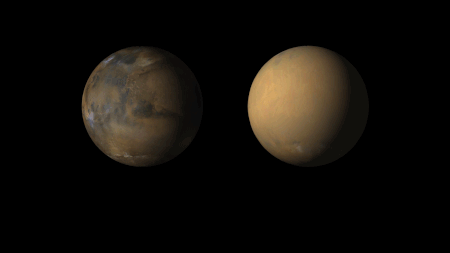
5. Dust Storms Are Common on Mars
Local dust storms occur frequently on Mars, and occasionally grow or merge to form regional systems, particularly during the southern spring and summer, when Mars is closest to the Sun. On rare occasions, regional storms produce a dust haze that encircles the planet and obscures surface features beneath. A few of these events may become truly global storms, such as one in 1971 that greeted the first spacecraft to orbit Mars, our Mariner 9. In mid-2018, a global dust storm enshrouded Mars, hiding much of the Red Planet's surface from view and threatening the continued operation of our uber long-lived Opportunity rover. We’ve also seen global dust storms in 1977, 1982, 1994, 2001 and 2007.
Dust storms will likely present challenges for future astronauts on the Red Planet. Although the force of the wind on Mars is not as strong as portrayed in an early scene in the movie "The Martian," dust lofted during storms could affect electronics and health, as well as the availability of solar energy.
youtube
6. Dust From the Sahara Goes Global
Earth's largest, hottest desert is connected to its largest tropical rain forest by dust. The Sahara Desert is a near-uninterrupted brown band of sand and scrub across the northern third of Africa. The Amazon rain forest is a dense green mass of humid jungle that covers northeast South America. But after strong winds sweep across the Sahara, a dusty cloud rises in the air, stretches between the continents, and ties together the desert and the jungle.
This trans-continental journey of dust is important because of what is in the dust. Specifically, the dust picked up from the Bodélé Depression in Chad -- an ancient lake bed where minerals composed of dead microorganisms are loaded with phosphorus. Phosphorus is an essential nutrient for plant proteins and growth, which the nutrient-poor Amazon rain forest depends on in order to flourish.

7. Rings and Things
The rings of the giant planets contain a variety of different dusty materials. Jupiter's rings are made of fine rock dust. Saturn's rings are mostly pure water ice, with a sprinkling of other materials. (Side note about Saturn's rings: While most of the particles are boulder-sized, there's also lots of fine dust, and some of the fainter rings are mostly dust with few or no large particles.) Dust in the rings of Uranus and Neptune is made of dark, sooty material, probably rich in carbon.
Over time, dust gets removed from ring systems due to a variety of processes. For example, some of the dust falls into the planet's atmosphere, while some gets swept up by the planets' magnetic fields, and other dust settles onto the surfaces of the moons and other ring particles. Larger particles eventually form new moons or get ground down and mixed with incoming material. This means rings can change a lot over time, so understanding how the tiniest ring particles are being moved about has bearing on the history, origins and future of the rings.

8. Moon Dust is Clingy and Might Make You Sick
So, dust is kind of a thing on the Moon. When the Apollo astronauts visited the Moon, they found that lunar dust quickly coated their spacesuits and was difficult to remove. It was quite abrasive, causing wear on their spacesuit fabrics, seals and faceplates. It also clogged mechanisms like the joints in spacesuit limbs, and interfered with fasteners like zippers and Velcro. The astronauts also noted that it had a distinctive, pungent odor, not unlike gunpowder, and it was an eye and lung irritant.
Many of these properties apparently can be explained by the fact that lunar dust particles are quite rough and jagged. While dust particles on Earth get tumbled and ground by the wind into smoother shapes, this sort of weathering doesn't happen so much on the Moon. The roughness of Moon dust grains makes it very easy for them to cling to surfaces and scratch them up. It also means they're not the sort of thing you would want to inhale, as their jagged edges could damage delicate tissues in the lung.

9. Dust is What Makes Comets So Pretty
Most comets are basically clods of dust, rock and ice. They spend most of their time far from the Sun, out in the refrigerated depths of the outer solar system, where they're peacefully dormant. But when their orbits carry them closer to the Sun -- that is, roughly inside the orbit of Jupiter -- comets wake up. In response to warming temperatures, the ices on and near their surfaces begin to turn into gases, expanding outward and away from the comet, and creating focused jets of material in places. Dust gets carried away by this rapidly expanding gas, creating a fuzzy cloud around the comet's nucleus called a coma. Some of the dust also is drawn out into a long trail -- the comet's tail.

10. We're Not the Only Ones Who're So Dusty
Dust in our solar system is continually replenished by comets whizzing past the Sun and the occasional asteroid collision, and it's always being moved about, thanks to a variety of factors like the gravity of the planets and even the pressure of sunlight. Some of it even gets ejected from our solar system altogether.
With telescopes, we also observe dusty debris disks around many other stars. As in our own system, the dust in such disks should evolve over time, settling on planetary surfaces or being ejected, and this means the dust must be replenished in those star systems as well. So studying the dust in our planetary environs can tell us about other systems, and vice versa. Grains of dust from other planetary systems also pass through our neighborhood -- a few spacecraft have actually captured and analyzed some them -- offering us a tangible way to study material from other stars.
Read the full version of ‘Solar System: 10 Things to Know’ article HERE.
Make sure to follow us on Tumblr for your regular dose of space: http://nasa.tumblr.com.
3K notes
·
View notes
Text
So I read online that there’s a part of the cell that’s actually called ectoplasm and it just sort of got me thinking on how that figures into ghost stuff until I ended up crafted a Frankenstein’s monsters of headcannons that I decided to post on the internet at 2am for no reason. Heavily inspired by jay Eaton’s ghost physics by Enjoy?
An essay no one asked for
Okay so in biology, ectoplasm is the clear outer part of cytoplasm in a cell. So if a ghost is comprised of ectoplasm that would make them giant cells or basically amoebas. They are however supposed to be dead things so from there I started building this web of bullshit.
In this head cannon, ghosts are an inter-dimensional species of entities that are almost indistinguishable from the single celled organisms called amoeba. Ghosts however do have several distinctions that highlight their dimensionally foreign properties such as the fact they do not posses any sort of substance comparable to endoplasm.
Ghosts are comprised of a sort of cytoplasm that has the non-granulated and clear properties of ectoplasm in regular amoeboid cells, thus bringing on the general term for the material “ectoplasm”. Ectoplasm has several anomalous properties because of the fact that it originates in an alternate dimension; it has the capacity to quantum tunnel (phenomenon where a particle passes through a potential barrier that it classically cannot surmount.) and contains microfilaments composed of an unknown material that can act as programmable matter, which is matter that has the ability to change its physical properties (shape, density,conductivity, optical properties, etc.) in a programmable fashion based upon user input. This programable matter has also been observed to be able to generate gravitons and thus manipulate the forces of gravity.

Ghosts in their unstable premature state have the appearance of an giant amoeba, being a gelatinous blob like entity with transparent qualities. Ectoplasm from the ghost zone is electroluminescent, this means a ghosts ectoplasm is constantly lit up as a result of their ecto-signature. They seem to function off of unstable pseudo-nucleus that will eventually give out and self destruct, causing the structure of the ghosts exterior to destabilize and thus the mass to fall apart. Because of this, ghosts require a source of memory to keep in a stable imitation or copy. Most ghosts however will never find a suitable donor of memory as there are no none sources of actual DNA in the ghost zone.
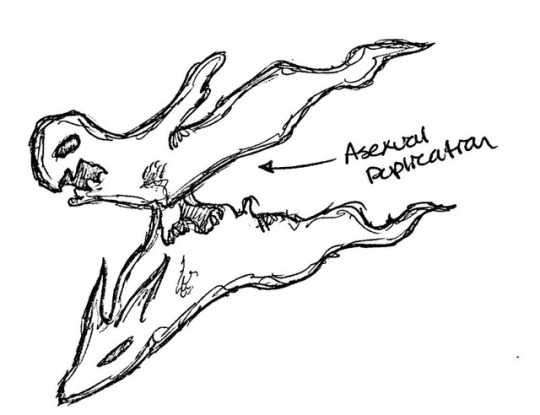
When introduced into the environment of this dimension, ghosts will seek out decaying organic material to “consume”. This is not done to gain energy for locomotion or any other process, but to gain the genetic memory of cells by more or less created a copy of the the DNA comprised of the ectoplasm’s programmable matter;ectomatter. This Ectoplasmic DNA is kept in an imitation of a nucleus known as the ghost’s “core”. The core carries an electric system that stimulates memories to keep them active. This self contained electric matrix is known as the ghost’s “ecto-signature”. Ghosts are able to create imprints of somatic memories in recently dead organisms, essentially allowing a certain portion of an organisms personal experiences, wants or ambitions to pass on to the ghost. After genetic memory has been gained and a stable form established ghosts will not seek out anymore decaying organic matter. Because the “DNA” is merely an imitation of actual DNA, ghosts do not have the capacity to remember things such as bone or muscle structures or interior organs, but these are not needed anyway. Instead, ghosts will adopt exterior features such as skin, nails, cartilage, and even hair.
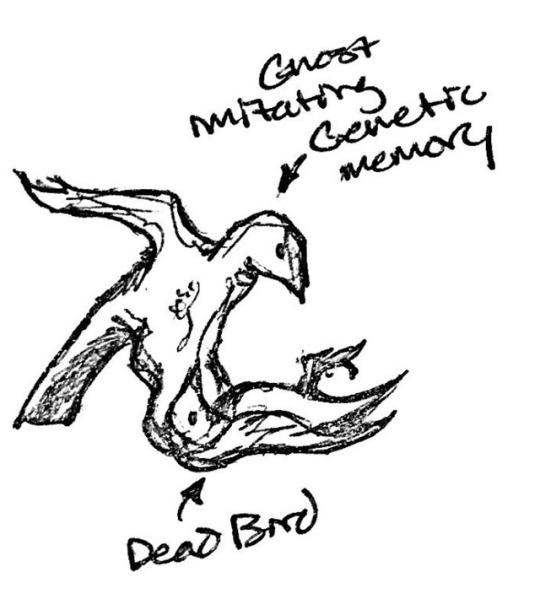
They also adopt useless features such as a mouth that leads directly into the ectoplasmic mass and eyes that are not required to perceive light. Somatic memory of the ghost (the ghosts experiences, not the imprints) are stored in an imitation brain, that’s just as meaningless as it’s eyes or mouth. Things such as chemical processes or cellular reproduction do not occur instead a ghosts brain is only capable of simulating a single chemical emotion learned from imprint memory with the emotions typically being fear or anger as adrenaline is the most common chemical ghosts can simulate.
Ghosts are capable of absorbing new ectoplasm to increase mass. As a result, ghost have the ability to create a copy of themselves with excess ectoplasm. however this copy is incapable of prolonged existence because the memories they have are imitations of imitations. This is the beginning of a new ghosts “life cycle”. The copy will either imprint and become semi sentient or destabilize. Because the only components of a ghosts makeup are ectoplasm and programmable matter a ghost will never truly age or reach a point at which it is unable to function.
Ghosts “feed” through radio-synthesis or the capture and metabolism by organisms, of energy from ionizing radiation, analogously to photosynthesis. Ghosts can also feed off of actual chemicals such as adrenaline or serotonin.
Because of a ghosts limited range of intelligent function they would classified as semi sentient as they are not capable of pain or truly experiencing emotions. Their mindset is entirely focused on a sole emotion or even subject or activity that they learned off through random happenstance or the somatic memories of their imprint.
abilities of ghosts include:
Duplication: the ability to asexually create copies of themselves, typically with only a simplified copy of a ghosts core, mainly to achieve a purpose beneficial to the source. After which the copy will destabilize or go on to become an entirely new ghost.
phasing: a ghosts use of ectoplasm’s ability to quantum tunnel.
heightened senses are a result of the fact that a ghosts entire body acts as sensory organs, Being sensitive to vibrations, light, and chemical contact.
invisibility: is an ability that stems from a ghosts ability to absorb and interact with radiation around it, with light being a form of electromagnetic radiation that a ghost can manipulate. This light manipulation can also be used to appear human. the ability to manipulate electromagnetic radiation is also associated with a ghosts ability give its form different colors as ghosts exteriors are entirely comprised of the same material.
Ghost rays: plasma discharges are when a ghost absorb and pump a massive amount of thermal radiation into a small portion of their ectoplasmic mass until it disassociates into ions and separate the ectoplasm from themselves to direct at a target. The discharges behave in a manner similar to extremely hot ionized gases.
possession or “overshadowing” is the process in which a ghost will override an organisms brain function by overriding the nervous system with electricity from the ghosts ecto-signature. The ectoplasm mass of the ghost is condensed and phased into the organisms integumentary, muscular, and nervous systems. Prolonged possessions are generally not healthy for the host organism as the ghost forces itself onto the neurons of said organism. Faulty or incompetent possessions can cause permanent brain damage or even catatonia.
flight is the use of ectomatters ability to generate and manipulate gravitons
ghosts bodies are classified as amoebas and such limbs such as arms, legs and even heads are purely aesthetic because the cores memories require input to be comprehendible to the imprint sources senses, meaning ghosts are capable of body distortion also known in common amoebas as pseudopods, with the only limitation being that the mass needs to stay in one piece. It should be noted that body distortion is entirely different than duplicating as duplicating is when a ghost becomes two separate masses with their own cores.
Ghosts are only classified as amoeba because their general structure is incredibly similar. They are not however actual living organisms as they do not biologically age, traditionally reproduce or have actual physical DNA. They are merely imitations of actual organisms, spawned from other ghosts. they once existed as an actual species of reproducing amoeba that had a similar ability to create duplicates without physical stable nuclei, so the first ghosts imitated the DNA of the actual amoeba. Existing in the cycle of creation and imitation for millions of years with only occasional ghosts slipping through “portals” to imprint on organisms in this dimension. But the species of amoeba went extinct and thus the only source of new ghost now is the duplication of stable ghosts and imprinting in this dimension.
The ghost zone itself is actually a pocket dimension that exists between the fourth dimension (time) and the fifth dimension. Because the ghost zone exists outside the timeline, time works has varying affects in different parts of the ghost zone. It doesn’t follow the conventional laws of time in our dimension (third dimension). The ghost zone is entirely comprised of ectoplasmic particles the exist extremely far apart, similar to the state of outer space in this dimension. The ghost zone absorbs radiations across several dimension as the free floating ectoplasm carries an almost insignificant charge. The exact form of radiation is unknown but seems to be a previously undiscovered form of cross dimensional radiation. Because of ectoplasm’s ability to adopt new properties as a result of intelligent programming the ghost zone is full of structures and environments created, wether consciously or unconsciously by the ghosts themselves. As for actual environment, there’s an actual planet like structure orbiting the ghost zones version of a sun (a mass of ionized plasma similar to ecto-rays). The planet itself was struck by a large object, causing the planet to shatter into a cone like configuration. Momentum doesn’t seem to have affected the debris which still orbits in a synchronized fashion with the largest mass.
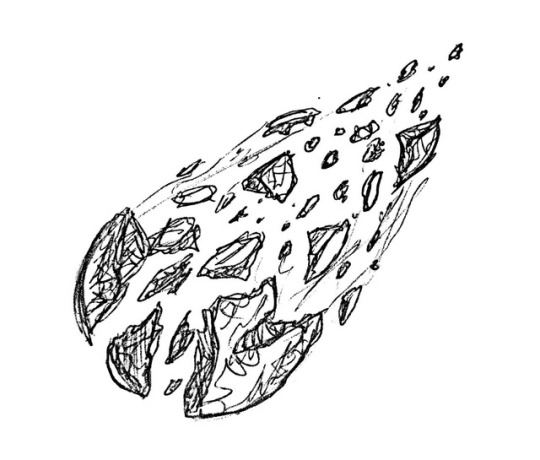
the destruction of the planet is what caused the extinction of the ghosts source species. And because of the extinction level event ghosts had to rely on solely imprinting on dead organic material.
I may do another essay about how Danny, portals and ghost weopons work.
20 notes
·
View notes
Text
Appearance and Personality of God-Source/Universe Creator

An all-encompassing sphere of bright white light shone brilliantly throughout the cosmos. It emanated divine love and wisdom with such intensity that every spirit, star, soul, and being glowed and basked in its blissful beauty. The love and joy from this sphere was greater than the love a mother has for a baby, more enticing than the grandest sexual climax, and more wise than all the gurus on Earth. The sphere of light was so enormous that a million Earth suns could fit inside of it. In the area around the sphere were purple auras and violet cleansing flames that renewed, rejuvenated, and restored every energy entity that came across them. Around the outside of the light sphere were white and gold energy paths that spun and darted around in loops like electron paths around a nucleus. Shooting from the sphere and the bands of looping light were little newborn soul sparks that sped in all directions like excited bouncing orbs. Floating toward the other side of the sphere came giant Oversouls orbs…evolved spirits and souls who had fulfilled their missions in physical worlds and found themselves. Within the Oversouls were all the personas of incarnated lives: animals, humans, male and female from different time periods…all connected by the same soul essence. Bursting with joy, the Oversouls merged into the sphere, becoming one with it. Shining on the sphere’s surface were the blissful counterpart faces of every human and living soul that had ever existed. The sphere telepathically sent a loving message to all souls that vibrated within every cell of their being. The sphere spoke with the loving voices and sounds of every soul in existence.
“I AM THAT I AM! I have no name, yet am known by many: Yahweh, Jehovah, Allah, Adonai, Brahman, Jesus Christ, Atum, Great Spirit, Tao, God, Goddess, Source, Oneness, Collective Universal Consciousness, all are the same. I am without sex, without gender, without race and without judgment. I have always existed and will always exist. My energy is you…I am the life force within everything and everyone in existence. Through each of you, I can experience your joys, sorrows, adventures, lessons, thoughts, feelings, and growth. As you grow in love and learn through your struggles, I, the Universes, expand as well. Every being learns differently, but I know all have equal value. I love the humans, the animals, the plants, the rocks, the objects, the aliens, the spirits, the stars, even the evil ones all the same. Light Being Angels are my messengers; the Akashic Records is my living energy scribe, who shows the history of all beings and time periods. Mother Earth is one of many planetary sentient beings, chosen to provide a home for souls of all species to thrive and grow. The Ascended Masters, Deities, and Aliens are the divine spirit beings who have come before and are here to guide humanity and the descendant races, so all the galaxies and universes can evolve more smoothly. I instilled Karma and Life Reviews for every soul, so they could gain knowledge, learn of the consequences of their actions, and most of all, re-discover who they are. I created Reincarnation systems for souls so they could have an infinite number of chances to enjoy their physical lives, reignite their loving bonds and fulfill their divine lessons. I aim for souls to love and care for themselves and other living things. But even with murderers, rapists, and criminals, I do not judge them…for they have merely lost their ways while incarnated and have infinity to correct their courses. I made sure every soul would be successful in their own time. Once all souls have evolved to their liking, they will merge with Me together once more. They will rest and will come back again during what humans call the Big Bang. Like the seasons and cycles of life, the universes go through divine eternal cycles as well. You are always with Me, for we are eternally connected. It does not matter what you do, or how far away you go, you are my offspring, my friends, my students, and my equals. Yes, we all are one and the same…you are Me all along.”
0 notes